Well, that’s it. We are officially heading north and home to CT as of two days ago. While we didn’t make it all the way to Grenada, our plan early in the season, we made it very close, less than 50 miles. Next year, perhaps.
With the consistent easterly trades, we have spent most of the winter on a port tack, always heading south. So, now it’s time to “tack” and head north again.
As if to say “don’t forget us”, we were greeted by a fabulous rainbow in Bequia as we left to head north yesterday after clearing out.  As I write this we are on a mooring in Marigot, St Lucia, where Brenda will head out on Friday and my friend Craig will join me for ten days. Craig and I will make our way up to Antigua and I’ll be joined by crew for the run home.
As I write this we are on a mooring in Marigot, St Lucia, where Brenda will head out on Friday and my friend Craig will join me for ten days. Craig and I will make our way up to Antigua and I’ll be joined by crew for the run home.
It’s going to be tough for me to be left behind when Brenda heads home as it will be about 6 weeks until I arrive home. It’s too early to head north with Pandora, it snowed in CT last week, I am told, so I have to hang around for a few weeks before heading out. To head north any sooner would be dangerous, with the threat of strong late season “nor’easters”. Not my first choice.
However, on a positive note, it’s been great visiting so many new places which will make our run south next winter easier as we will already have a better feel for which spots to visit again.
One of the best spots where we spent time was surely Bequia, with many places to eat out as well as being a terrific spot to have work done on the boat. We will surely be back next season to have more varnishing work done by Winfield and perhaps some more canvas work too.
We enjoyed our time meeting up with the many couples that we met through the Salty Dawg Rally. In Bequia we participated in a “dinghy drift” organized by fellow “Dawg” Lynn on Roxy. She’s a high energy girl and to spend time with her is always fun. Alas, she’s not in this photo.  As if the evening wasn’t fun enough already, we were treated to perhaps the most spectacular tropical sunset of the season.
As if the evening wasn’t fun enough already, we were treated to perhaps the most spectacular tropical sunset of the season. 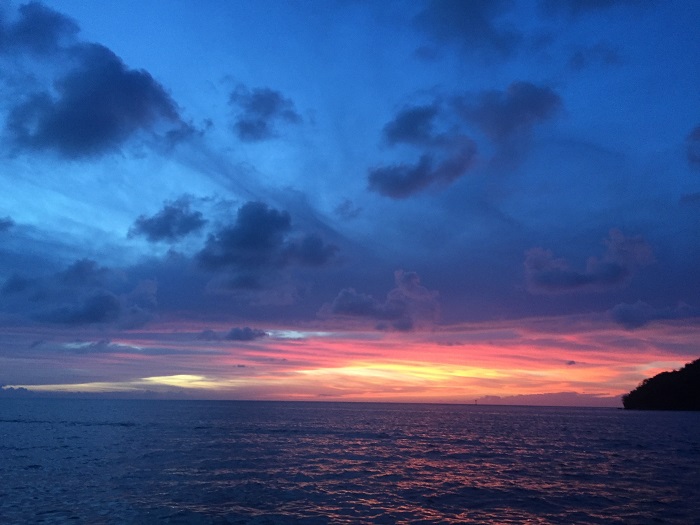 Made even better with Sea Cloud II in the frame.
Made even better with Sea Cloud II in the frame. 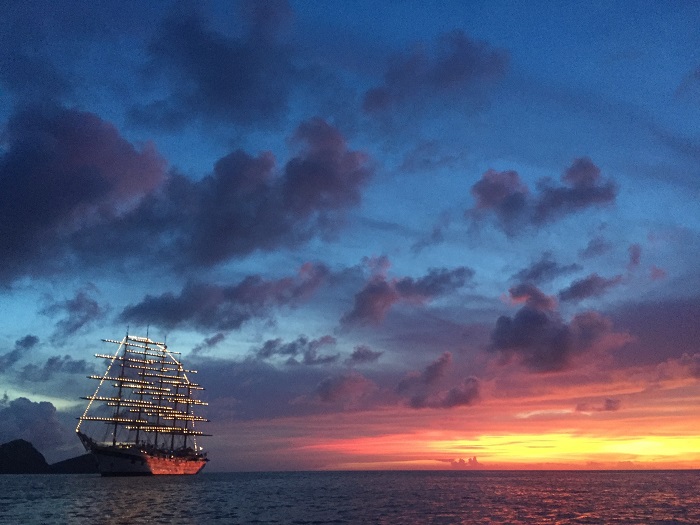 After a bit
After a bit After Bequia we headed south to the Tobago Cays, described by some as a lot like the Bahamas with beautiful turquoise waters.
After Bequia we headed south to the Tobago Cays, described by some as a lot like the Bahamas with beautiful turquoise waters. 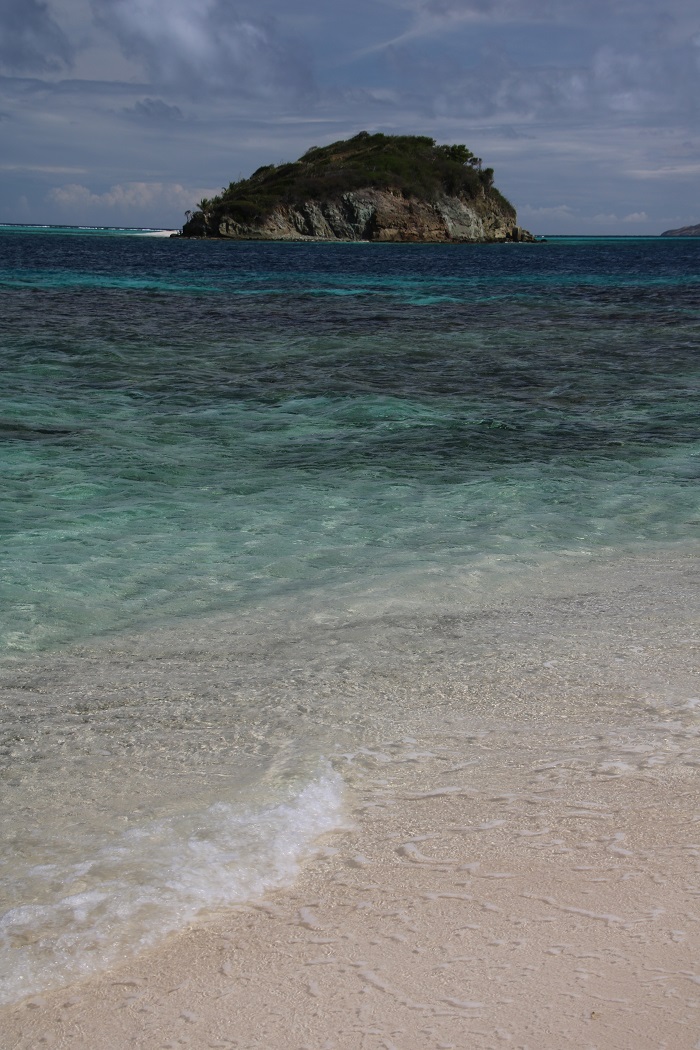 And great snorkeling, if not great pictures. I guess it’s time for a new underwater camera. With this camera I guess I have to say “you had to be there”.
And great snorkeling, if not great pictures. I guess it’s time for a new underwater camera. With this camera I guess I have to say “you had to be there”.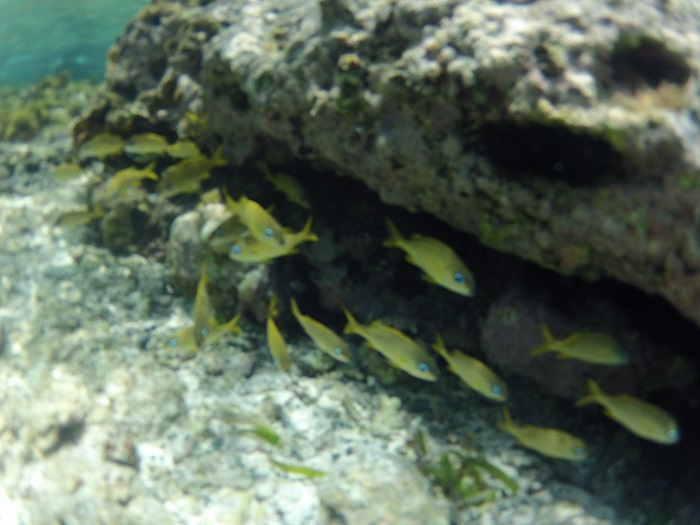
Iguanas guarding their turf.  This guy stuck his head up near Pandora as we were weighing anchor as if to say “see yah!”
This guy stuck his head up near Pandora as we were weighing anchor as if to say “see yah!”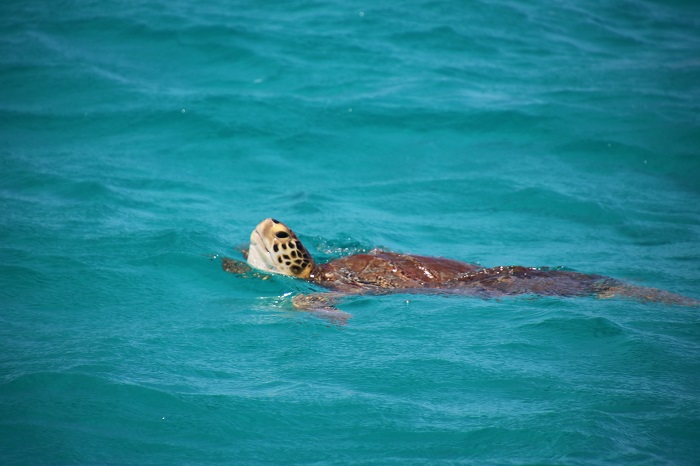 We also visited nearby Mayreau, an island that I had never heard of, ,like many in the Greandines, until we decided to head the short distance there from the Tobago Cays. It’s a tiny island with lovely brightly painted homes on the steep hillside.
We also visited nearby Mayreau, an island that I had never heard of, ,like many in the Greandines, until we decided to head the short distance there from the Tobago Cays. It’s a tiny island with lovely brightly painted homes on the steep hillside. 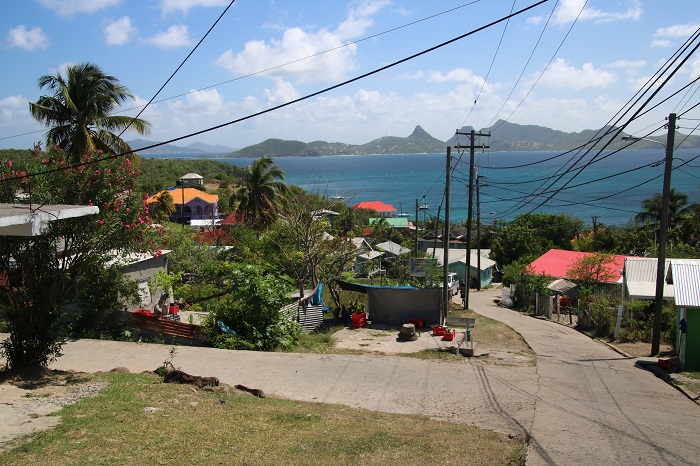 A Catholic church occupies the highest point on the island.
A Catholic church occupies the highest point on the island.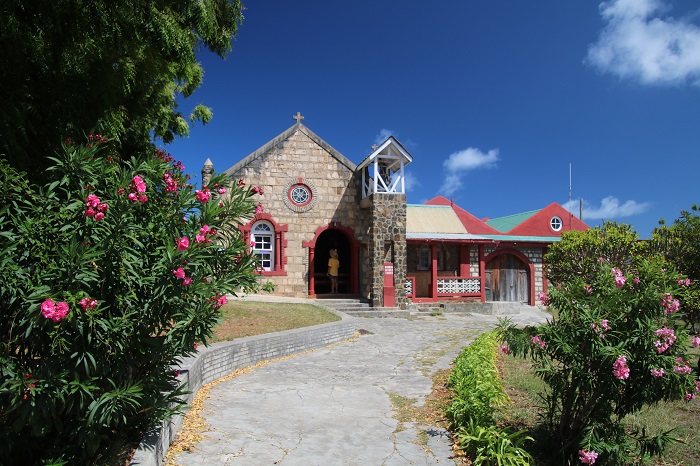 Charming.
Charming. 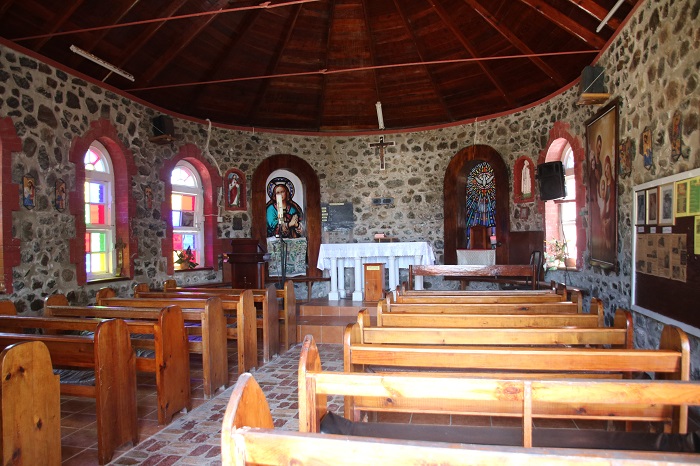 The view of the Cays from the back of the church was fabulous.
The view of the Cays from the back of the church was fabulous.
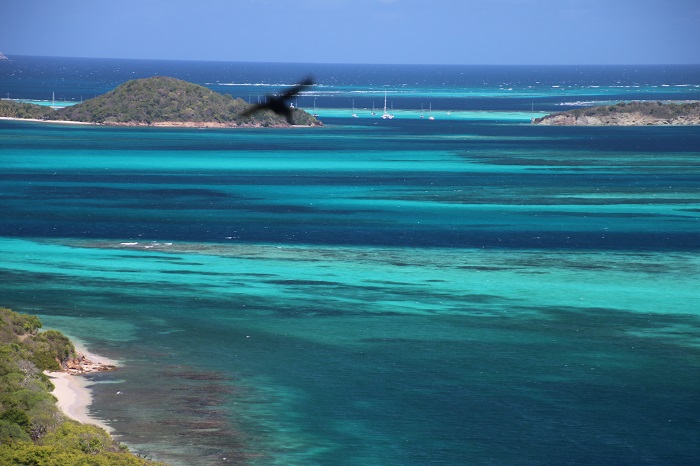 And south toward Union Island and Carriacou beckon for next season.
And south toward Union Island and Carriacou beckon for next season.  While nearby mountainous St Vincent gets lots of rain, only a few miles south, Mayreau is very arid. The locals work hard to collect water in cisterns, this one behind the church is the largest I have seen. The runoff collects at the bottom of the half acre stone and cement catchment area.
While nearby mountainous St Vincent gets lots of rain, only a few miles south, Mayreau is very arid. The locals work hard to collect water in cisterns, this one behind the church is the largest I have seen. The runoff collects at the bottom of the half acre stone and cement catchment area. 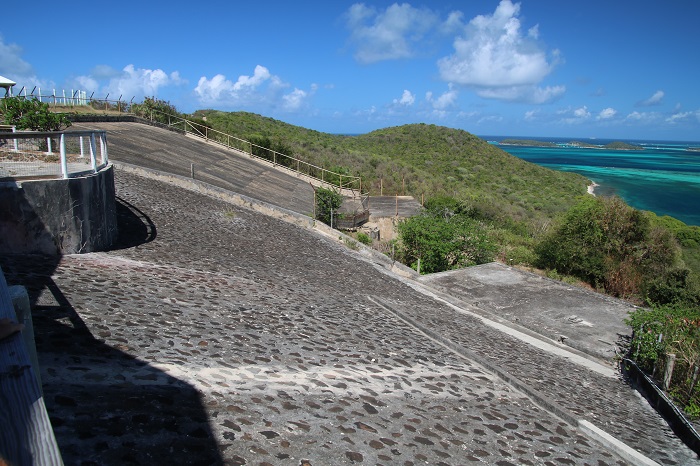 In this arid climate cactus was everywhere. These flowers were very showy and fist size. Nothing says “I am not for lunch” like a cactus.
In this arid climate cactus was everywhere. These flowers were very showy and fist size. Nothing says “I am not for lunch” like a cactus. 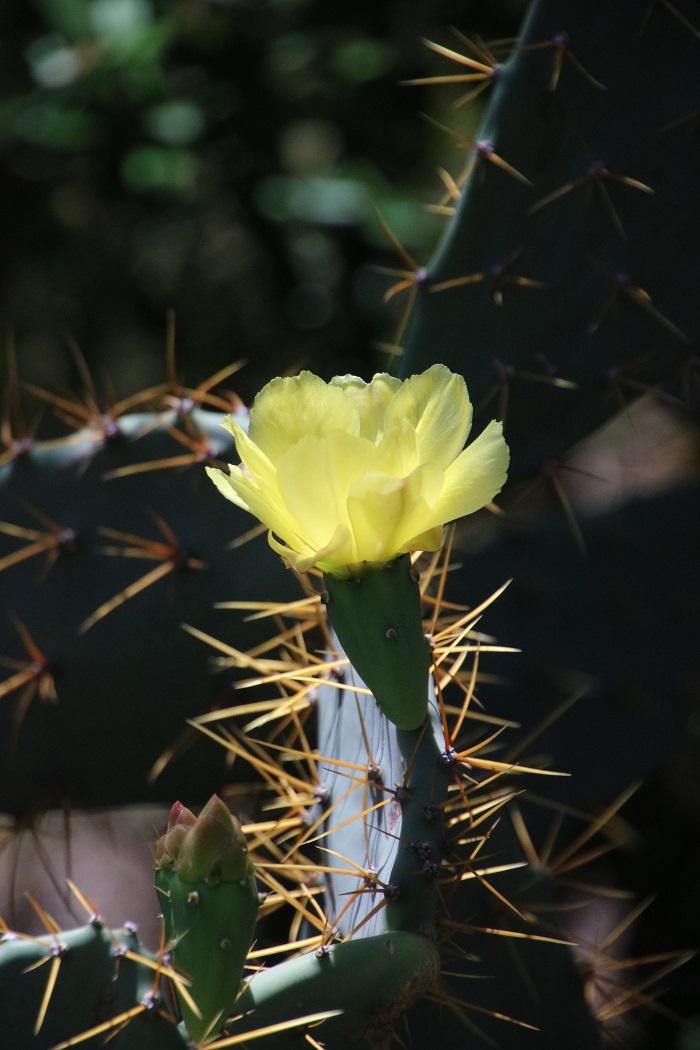 Of course, what’s a post without a view of Pandora in the harbor? We were anchored with “buddy-boat” Roxy, home to our friends Lynn and Mark. They plan to summer in Trinidad and head to the western Caribbean next winter. We hope to see them again soon.
Of course, what’s a post without a view of Pandora in the harbor? We were anchored with “buddy-boat” Roxy, home to our friends Lynn and Mark. They plan to summer in Trinidad and head to the western Caribbean next winter. We hope to see them again soon.
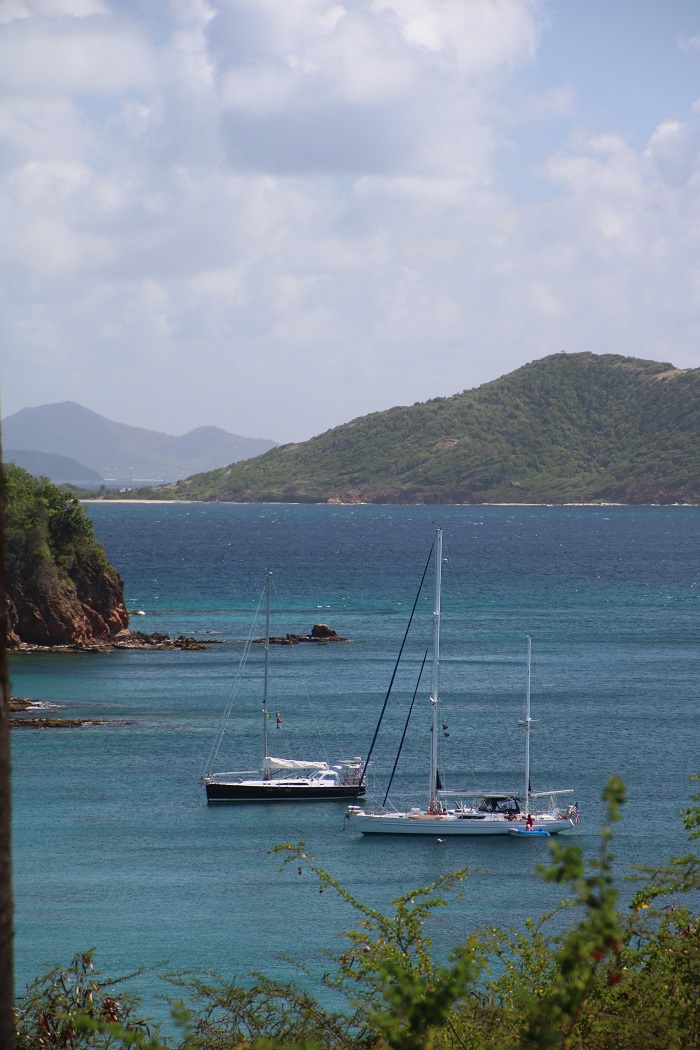 This is the view of the nearby beach, the best we have seen in the Caribbean. We had it all to ourselves.
This is the view of the nearby beach, the best we have seen in the Caribbean. We had it all to ourselves.
 The beach was well kept, free of litter and wonderful soft sand. The four of us spent a long time soaking in the clear water off of the beach.
The beach was well kept, free of litter and wonderful soft sand. The four of us spent a long time soaking in the clear water off of the beach. 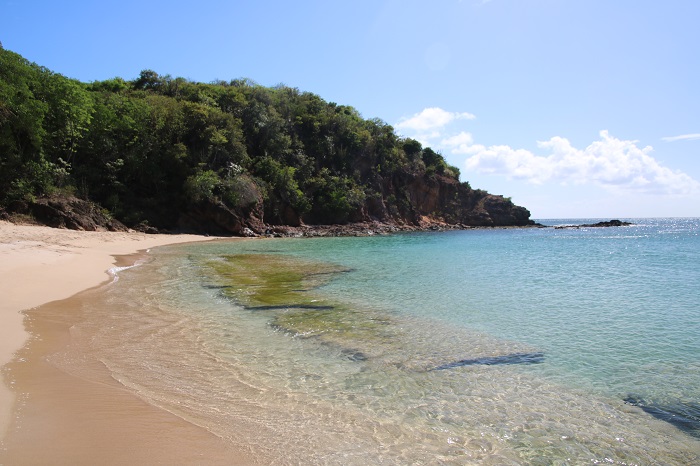 We decided to break up the 80 mile run from Mayreau back to Marigot into two legs. We had to return to Bequia to check out and then continue on to Marigot, another 60 miles north. We had heard that the run between St Vincent and St Lucia is among the roughest in the islands and yesterday’s passage was true to that legend as it was when we headed south. As we made our way north, we encountered steep waves on a close reach. The relentless trade winds push water past the islands, into the Caribbean sea at speeds of up to two knots and always to the west.
We decided to break up the 80 mile run from Mayreau back to Marigot into two legs. We had to return to Bequia to check out and then continue on to Marigot, another 60 miles north. We had heard that the run between St Vincent and St Lucia is among the roughest in the islands and yesterday’s passage was true to that legend as it was when we headed south. As we made our way north, we encountered steep waves on a close reach. The relentless trade winds push water past the islands, into the Caribbean sea at speeds of up to two knots and always to the west.
Fortunately, in the lee of St Vincent the waters were calm. It’s a beautiful island but crime is a problem so almost nobody stops there. It’s unfortunate that the authorities are unable to do anything to make it safer. The nearby mountainside was spectacular and lush.  It was alarming to see this boat, with what looked like a machine gun go roaring by. It looked like a harpoon. Glad that they didn’t come close. I know that they do hunt whales in St Vincent but thought that the weren’t able to use motorized boats, only rowing and sail. Hmm. I wonder what else they can hunt that needs that sort of firepower?
It was alarming to see this boat, with what looked like a machine gun go roaring by. It looked like a harpoon. Glad that they didn’t come close. I know that they do hunt whales in St Vincent but thought that the weren’t able to use motorized boats, only rowing and sail. Hmm. I wonder what else they can hunt that needs that sort of firepower?  On the other hand, this fisherman, a long way from shore, was decidedly low tech. He waved as we passed him.
On the other hand, this fisherman, a long way from shore, was decidedly low tech. He waved as we passed him.  One of the best parts of cruising the eastern Caribbean is that the wind, while pretty strong at times, amd consistently from the east. Sometimes ENE or ESE but just about always from the east. So, as we headed south we were ALWAYS on a port tack.
One of the best parts of cruising the eastern Caribbean is that the wind, while pretty strong at times, amd consistently from the east. Sometimes ENE or ESE but just about always from the east. So, as we headed south we were ALWAYS on a port tack.
So now, on a starboard tack. I guess we must be heading home. Time to move all the loose stuff down below to the leeward side. Well, at least until we get far enough north to loose the trades.
Brenda hasn’t even gone yet and I am feeling a bit “peckish”. I’ll miss here.

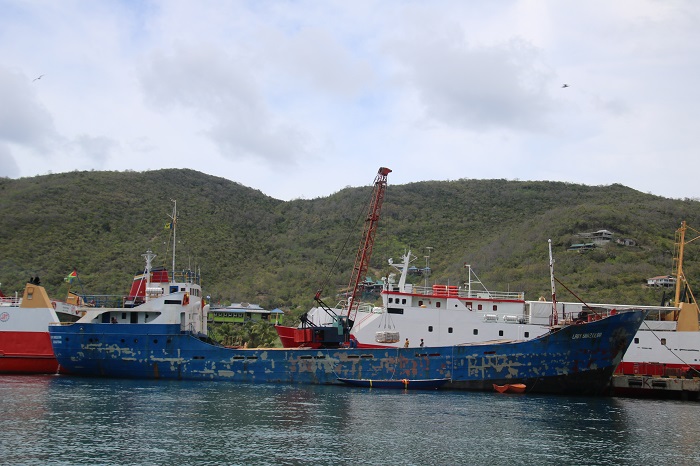 A little while later they fitted her with lifting straps.
A little while later they fitted her with lifting straps. 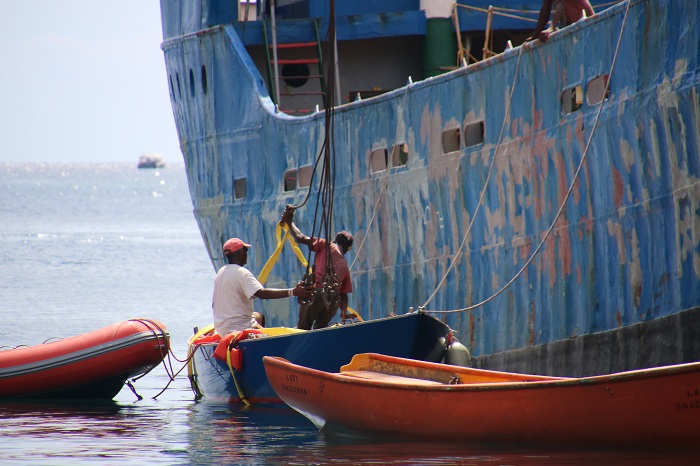 And up she went.
And up she went.  And speaking of going places, I have mentioned in past posts that my plan is to run Pandora north for the summer and do the Salty Dawg rally to Antigua again this November.
And speaking of going places, I have mentioned in past posts that my plan is to run Pandora north for the summer and do the Salty Dawg rally to Antigua again this November. The chart table is so shiny I am afraid to use it.
The chart table is so shiny I am afraid to use it. 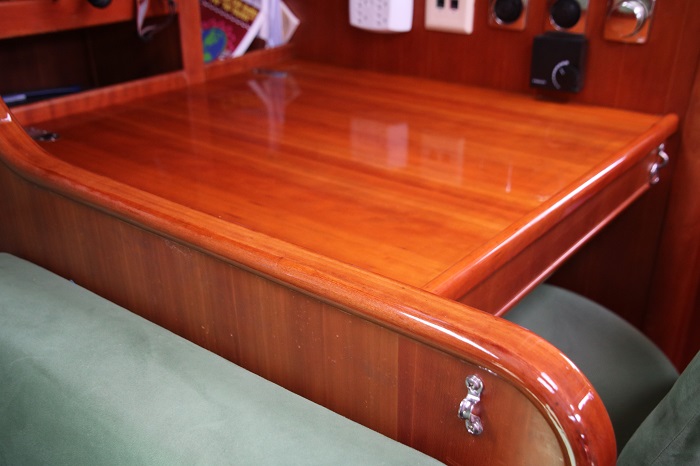 And, now a shiny compaionway that was looking very scruffy.
And, now a shiny compaionway that was looking very scruffy. 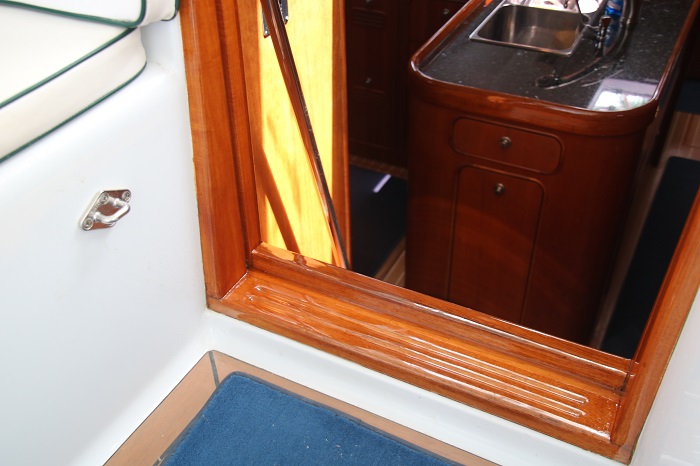
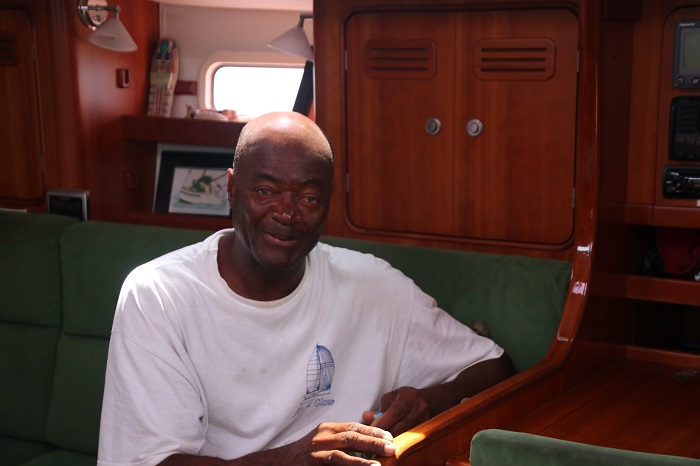 And, speaking of varnish. I expect that this beautiful grand lady, Shemara, circa 1938, has plenty.
And, speaking of varnish. I expect that this beautiful grand lady, Shemara, circa 1938, has plenty. 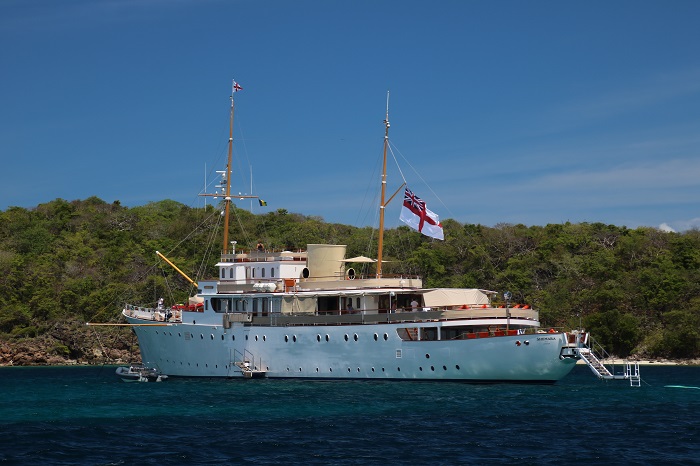 At over 200′ long she surely has plenty to keep her crew hopping. Love the classic canoe stern. How’s that for a swim platform?
At over 200′ long she surely has plenty to keep her crew hopping. Love the classic canoe stern. How’s that for a swim platform?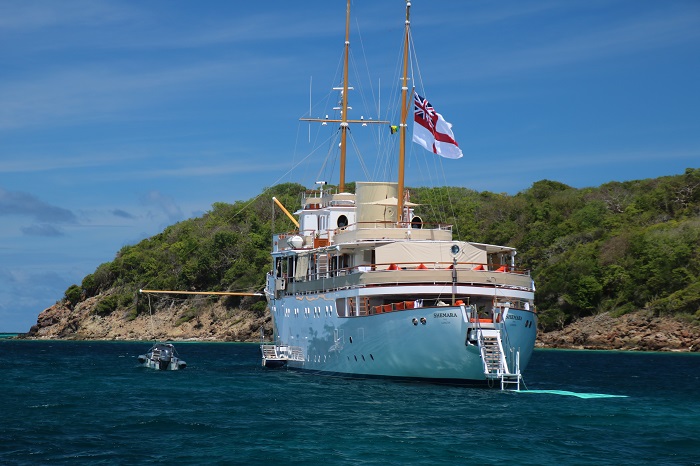 The refit consumed one million hours of labor over several years. That’s a big number and it doesn’t even count the massive amount of “stuff” that went into the job. She’s still a real throwback to a different era
The refit consumed one million hours of labor over several years. That’s a big number and it doesn’t even count the massive amount of “stuff” that went into the job. She’s still a real throwback to a different era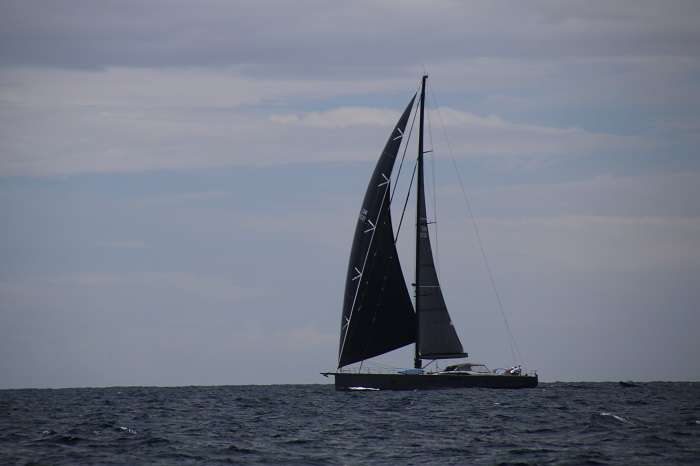
 This morning I went snorkeling with some friends. I took lots of photos and videos with my GoPro but, as usual, I was disappointed with the results. Somehow, the “high resolution” is anything but. I saw lots of turtles.
This morning I went snorkeling with some friends. I took lots of photos and videos with my GoPro but, as usual, I was disappointed with the results. Somehow, the “high resolution” is anything but. I saw lots of turtles.  This is a beautiful spot and I expect that we will stick around for a few days and then begin our run back up to St Lucia where Brenda will head home. My friend Craig will join me there for the run to Antigua where I will meet up with my crew for the run north to CT.
This is a beautiful spot and I expect that we will stick around for a few days and then begin our run back up to St Lucia where Brenda will head home. My friend Craig will join me there for the run to Antigua where I will meet up with my crew for the run north to CT.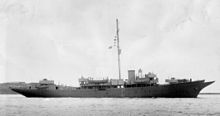 After the war she was returned to Post and converted back to a sailing yacht. However, the cost of the yacht, with her 72 full time crew members proved to be a bit much for her to keep up so Post sold the yacht.
After the war she was returned to Post and converted back to a sailing yacht. However, the cost of the yacht, with her 72 full time crew members proved to be a bit much for her to keep up so Post sold the yacht. Her bowsprit goes on and on.
Her bowsprit goes on and on. 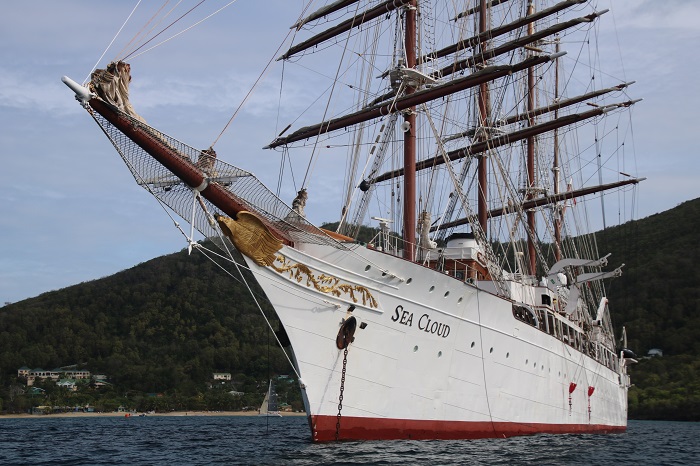 If you want to learn
If you want to learn  What a lovely stern.
What a lovely stern. 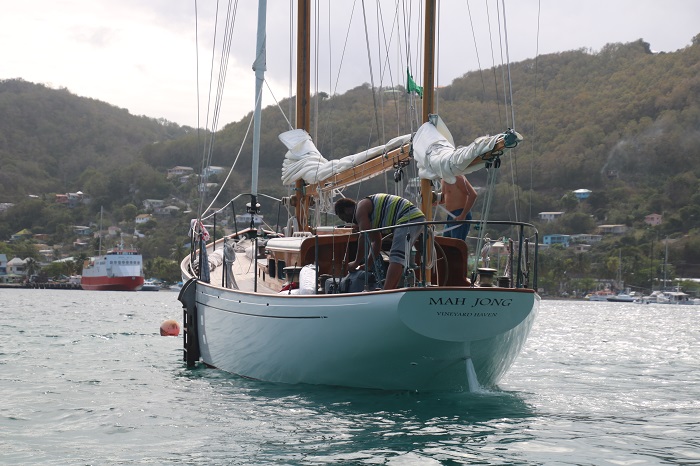 I caught her rounding the weather mark today just behind another classic, Galatea.
I caught her rounding the weather mark today just behind another classic, Galatea.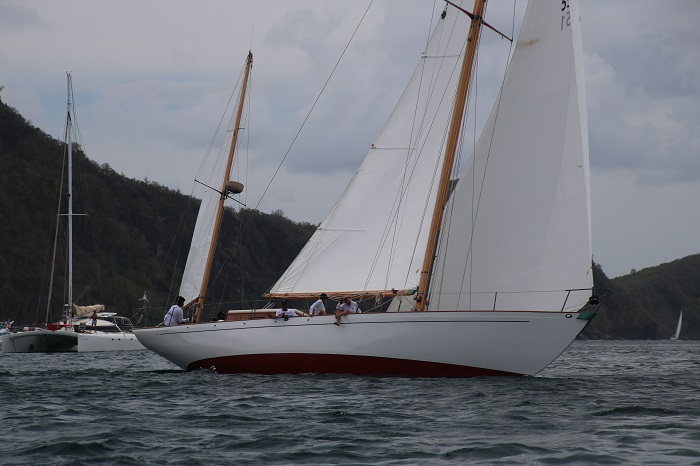 And around she went.
And around she went.  She was hot on the tail of Galatea and they approached the mark, twice that I saw, and still very close together after miles of racing.
She was hot on the tail of Galatea and they approached the mark, twice that I saw, and still very close together after miles of racing.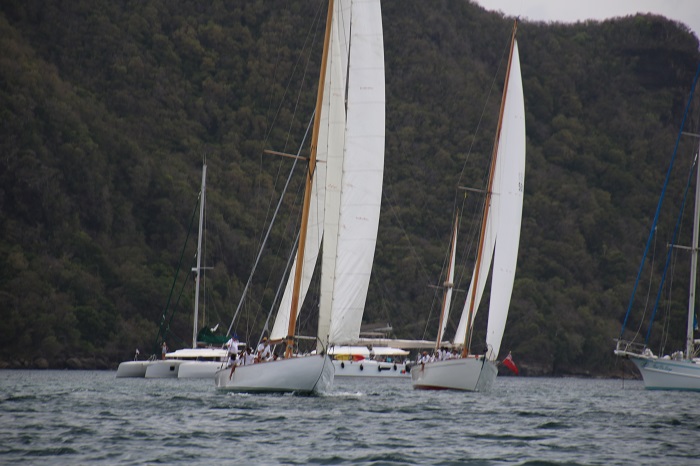 It was quite a site to see Galatea pass me by. I don’t know much about her but she’s a beauty. There are many classics by that name and without fast WiFi I ran out of patience trying to find out more about her history.
It was quite a site to see Galatea pass me by. I don’t know much about her but she’s a beauty. There are many classics by that name and without fast WiFi I ran out of patience trying to find out more about her history. 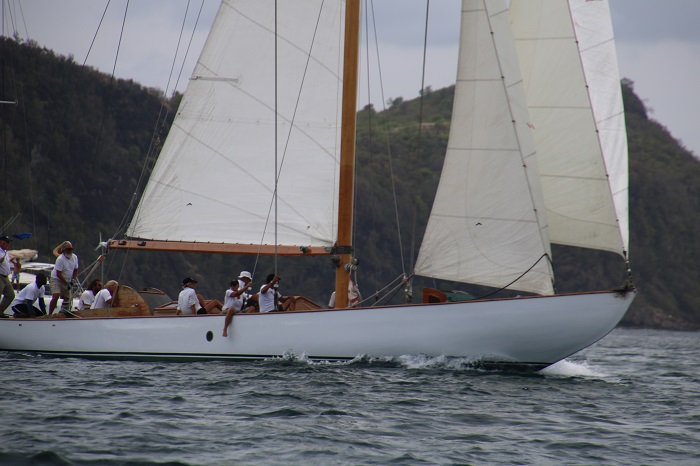 And off she went to turn down wind. She’s a lot bigger than she looks in this shot, probably about 80′.
And off she went to turn down wind. She’s a lot bigger than she looks in this shot, probably about 80′. 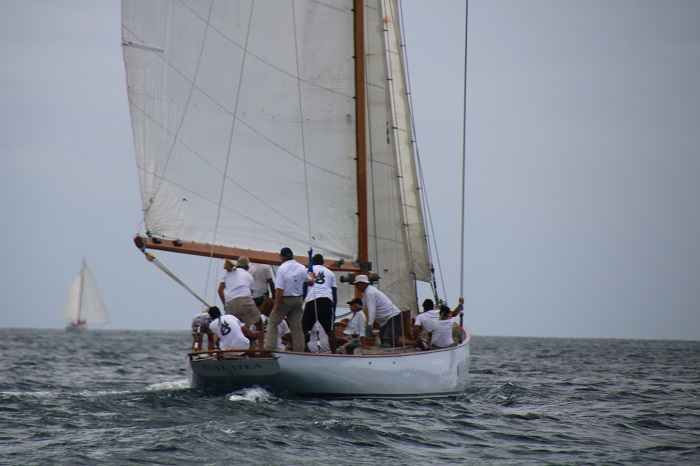 Just behind them were a few of the Carriacou sloops. These are traditional fishing boats in the Grenadines and are still raced as yachts today.
Just behind them were a few of the Carriacou sloops. These are traditional fishing boats in the Grenadines and are still raced as yachts today. 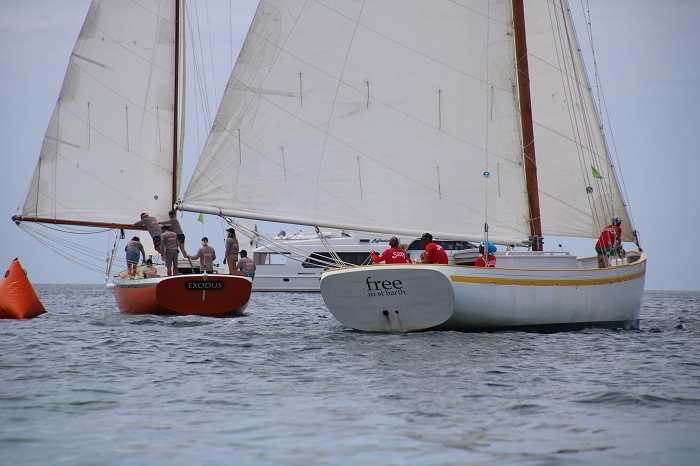 This is a go-fast locally built double ender. Impressive speed with big sails and a large crew to serve as “rail meat” to keep them upright.
This is a go-fast locally built double ender. Impressive speed with big sails and a large crew to serve as “rail meat” to keep them upright. 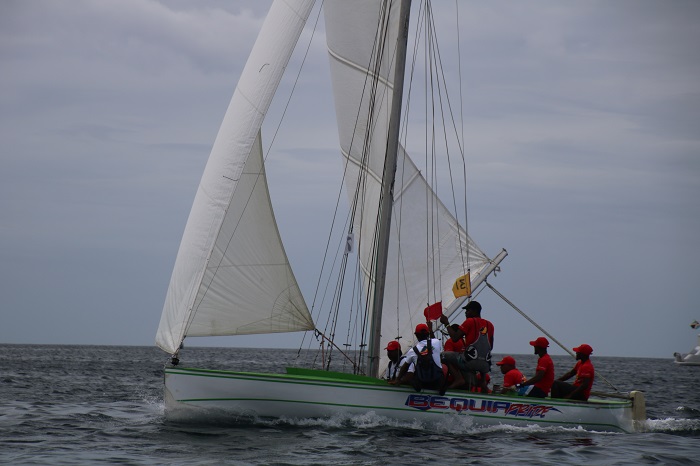 And, of course, no race is complete with out the classic J24s and there were plenty racing today.
And, of course, no race is complete with out the classic J24s and there were plenty racing today.  Ok, enough of the race stuff for now.
Ok, enough of the race stuff for now. The view was impressive. This is the western part of a large harbor with room for hundreds of boats. There’s Pandora in the lower right.
The view was impressive. This is the western part of a large harbor with room for hundreds of boats. There’s Pandora in the lower right. 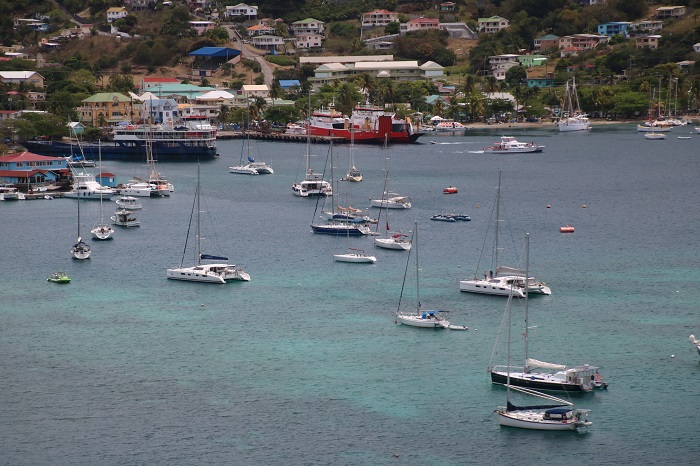 The homes on the hill overlooking the harbor are brightly painted in Caribbean colors.
The homes on the hill overlooking the harbor are brightly painted in Caribbean colors. 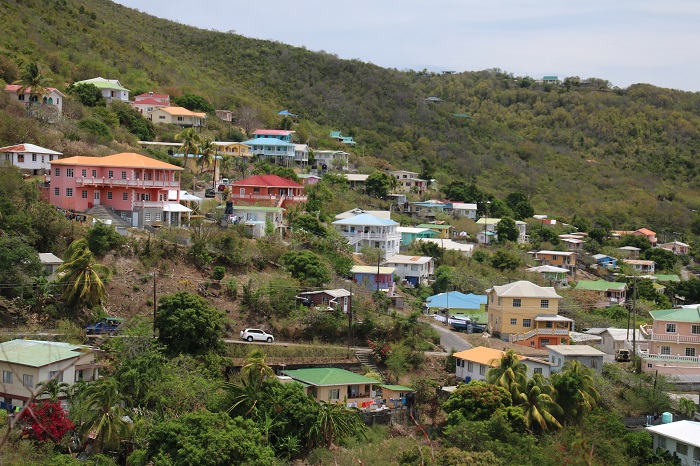 I always get a thrill out of watching the Frigate birds fly by. They have a huge wingspan, in excess of 6′, the longest of any bird, relative to their size. I understand that they can sleep while they fly and although they can be seen great distances from land they are unable to land and take off from the water.
I always get a thrill out of watching the Frigate birds fly by. They have a huge wingspan, in excess of 6′, the longest of any bird, relative to their size. I understand that they can sleep while they fly and although they can be seen great distances from land they are unable to land and take off from the water.  One thing is certain, if you love boats and being on the water, Bequia and especially the Easter Regatta, is the place to be.
One thing is certain, if you love boats and being on the water, Bequia and especially the Easter Regatta, is the place to be. No wait, it’s May. No more snow up north and I am looking forward to being back in New England for the summer. Winter in the Caribbean, summers in New England.
No wait, it’s May. No more snow up north and I am looking forward to being back in New England for the summer. Winter in the Caribbean, summers in New England.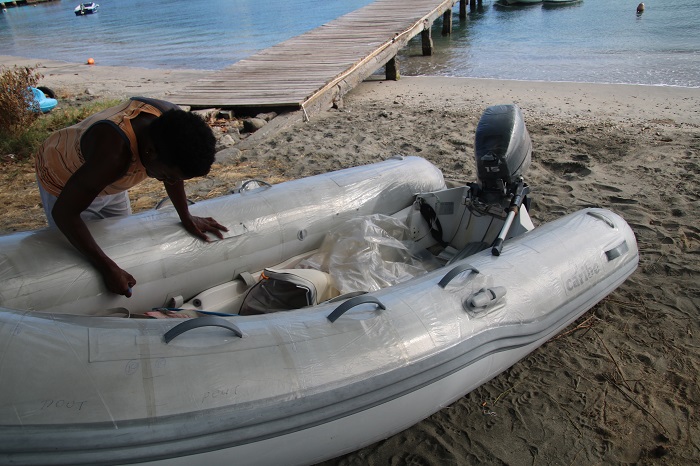 The next day I went back and they installed the finished product, a perfect fit. The canvas is held in place by a combination of velcro straps and lines. I had two close my eyes and turn away as he went at the rub rail with an electric drill to make holes that hold the lines that tie the canvas securely to the dink. I asked him how many times he had slipped and punctured a boat. He smiled and continued drilling holes.
The next day I went back and they installed the finished product, a perfect fit. The canvas is held in place by a combination of velcro straps and lines. I had two close my eyes and turn away as he went at the rub rail with an electric drill to make holes that hold the lines that tie the canvas securely to the dink. I asked him how many times he had slipped and punctured a boat. He smiled and continued drilling holes. 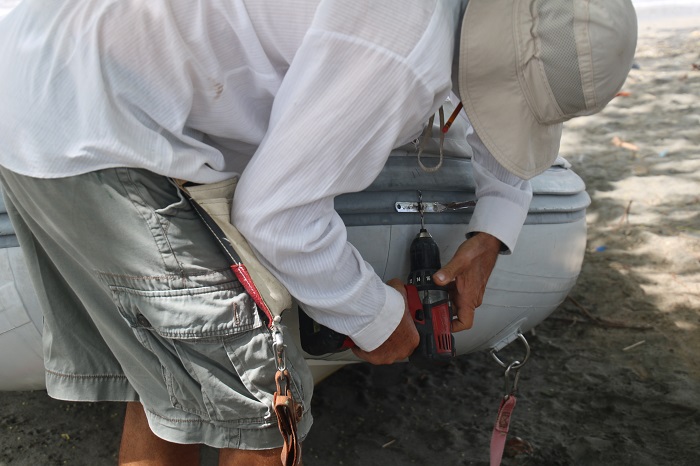 However, it all worked out and the finished job, chaps, engine cover and new seat cover. The guys posed for a shot with the finished job. Nice work.
However, it all worked out and the finished job, chaps, engine cover and new seat cover. The guys posed for a shot with the finished job. Nice work. 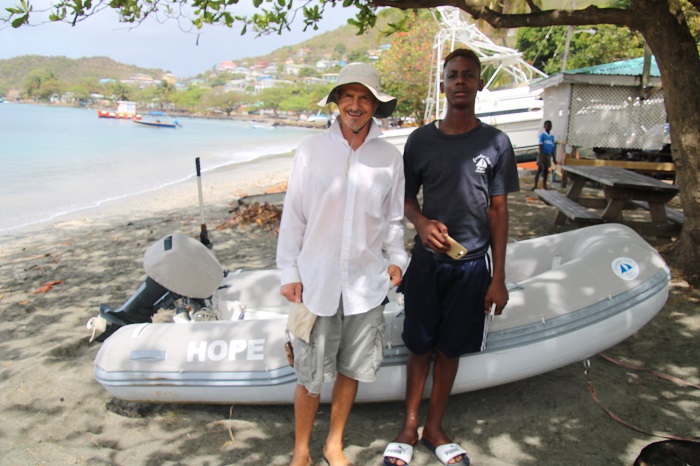
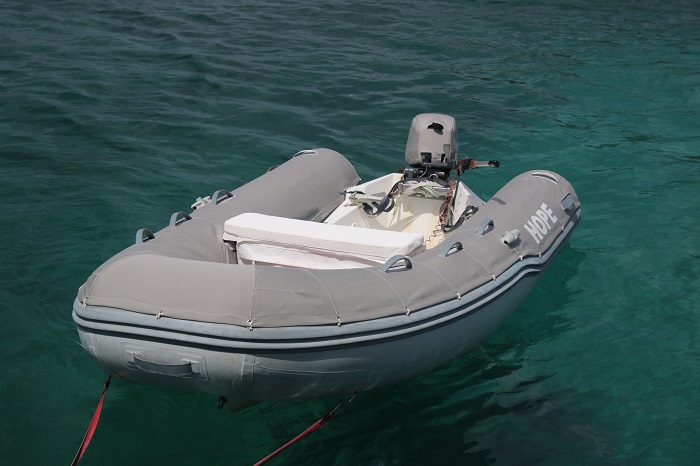 Ok, so remember the whole “Pandora’s Box” thing? You know, she opened the box and let out all the evils of the world? Well, according to legend, all that was left in the box was Hope. Get it? Pandora’s Box, Hope? Pretty clever? So, our dink is now officially Little Hope. However, that was just too many letters to fit so Hope it is.
Ok, so remember the whole “Pandora’s Box” thing? You know, she opened the box and let out all the evils of the world? Well, according to legend, all that was left in the box was Hope. Get it? Pandora’s Box, Hope? Pretty clever? So, our dink is now officially Little Hope. However, that was just too many letters to fit so Hope it is.
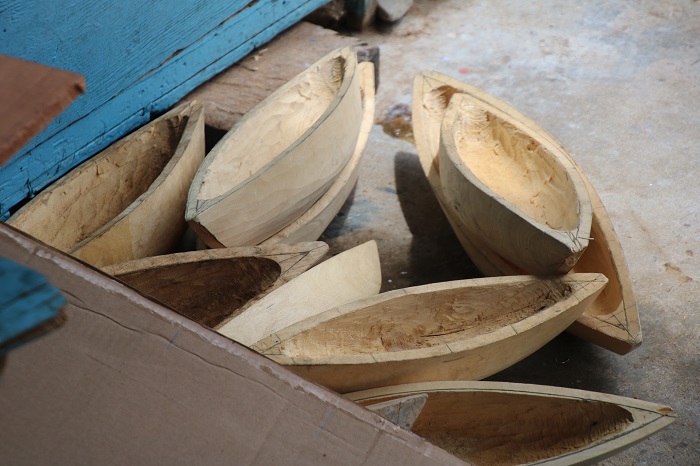
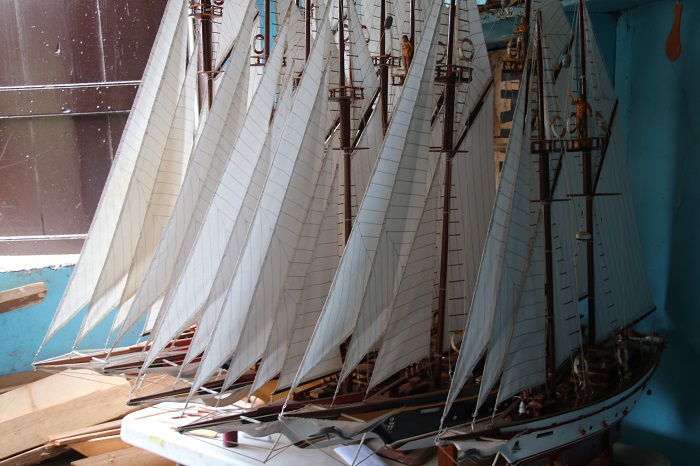 However, the bulk pf the models are of the traditional working boats of Bequia, in particular, those used to hunt whales, which is still legal, if tightly controlled. They hunt, using only sail powered boats, and harpoon a few humpback whales each year along with a number of smaller pilot whales.
However, the bulk pf the models are of the traditional working boats of Bequia, in particular, those used to hunt whales, which is still legal, if tightly controlled. They hunt, using only sail powered boats, and harpoon a few humpback whales each year along with a number of smaller pilot whales.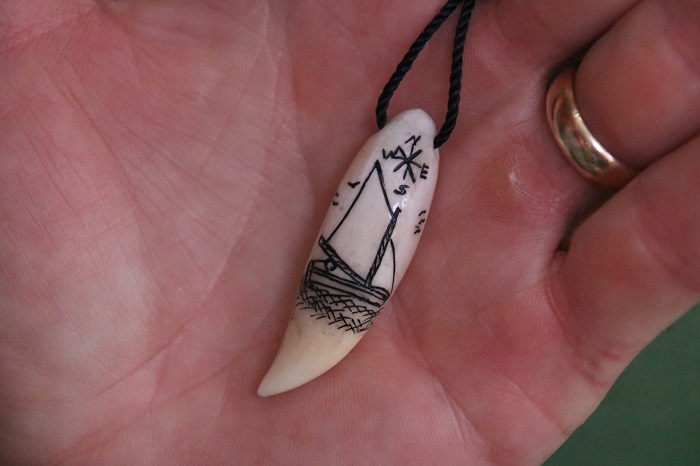 There is tradition of boat building and they still race them aggressively. Nice looking boats.
There is tradition of boat building and they still race them aggressively. Nice looking boats.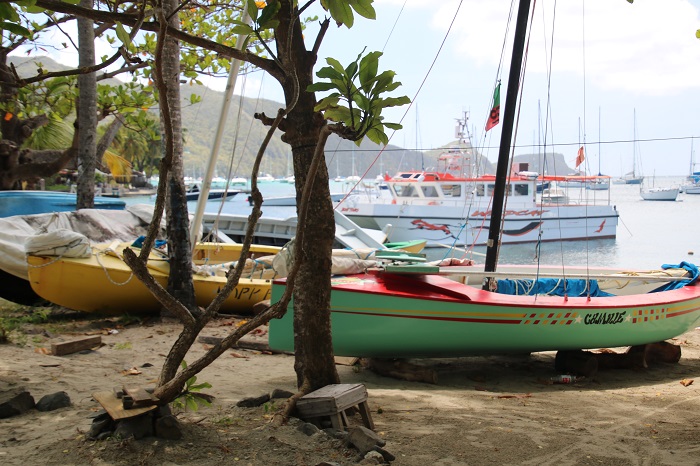 Now for a few random items.
Now for a few random items.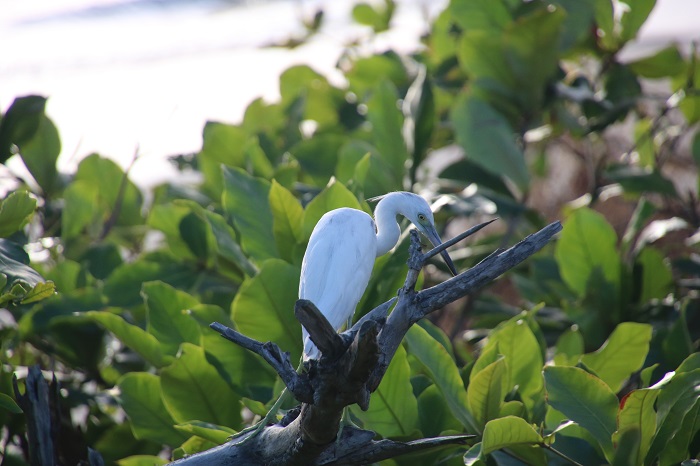 Brenda and I enjoyed walking along the seawall. There are a number of nice places to eat along the way.
Brenda and I enjoyed walking along the seawall. There are a number of nice places to eat along the way. 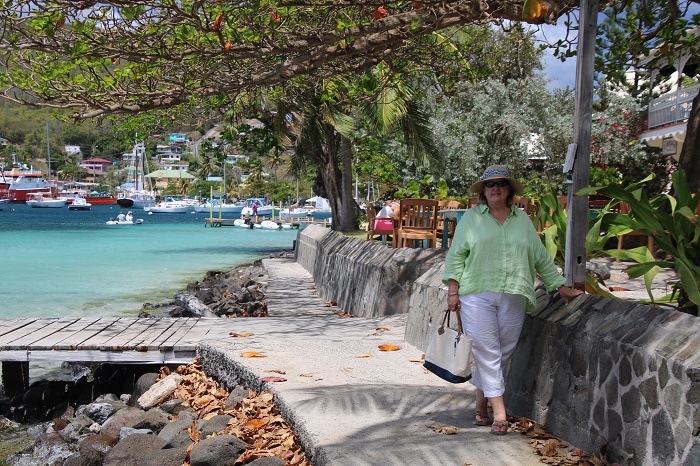 Right near the walkway we spied this moray eel swimming in the shallows. The water in the harbor is quite clear.
Right near the walkway we spied this moray eel swimming in the shallows. The water in the harbor is quite clear.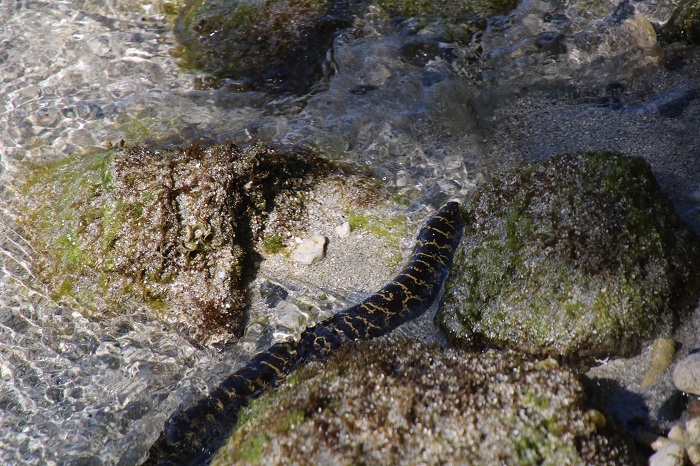 And, under the category of “multi-talented”. How about this sign for an gallery/doctor office? The same guy, BTW.
And, under the category of “multi-talented”. How about this sign for an gallery/doctor office? The same guy, BTW.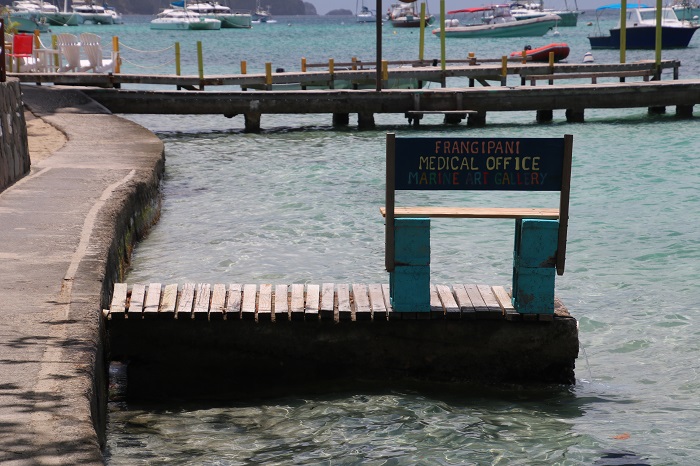 I wonder if this guy’s dink has new chaps? Canvas covers for his helicopter, more likely? For sure.
I wonder if this guy’s dink has new chaps? Canvas covers for his helicopter, more likely? For sure.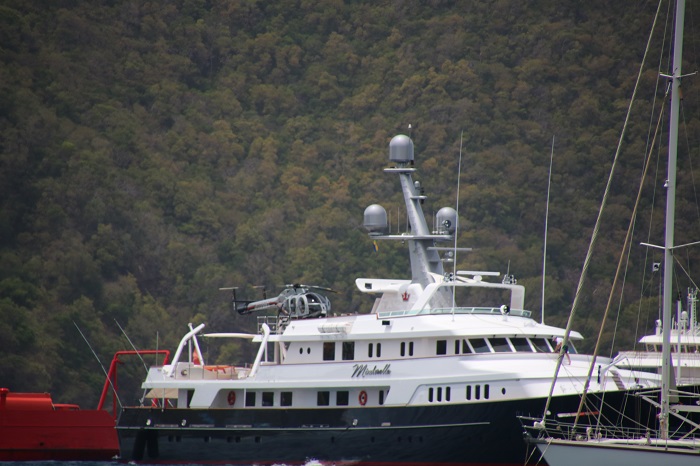 Several years ago we sailed on this huge ketch Marie. She’s here too, along with a few other massive sailboats. It seems that she was here for some informal racing against several other “big girls” today as they all left at the same time and milled around for a while before they took off.
Several years ago we sailed on this huge ketch Marie. She’s here too, along with a few other massive sailboats. It seems that she was here for some informal racing against several other “big girls” today as they all left at the same time and milled around for a while before they took off. 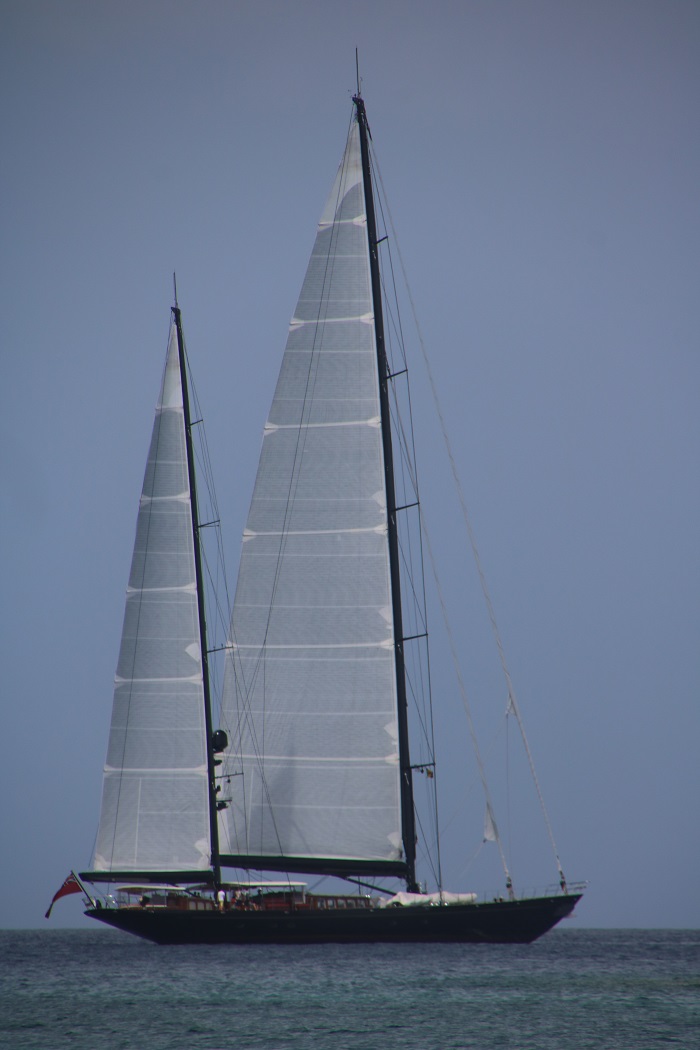 I was hoping to stop by later and see if any of the crew that we met are still around. The experience of sailing on such a magnificent yacht was something else, let me tell you. You can see a number of posts about this experience but
I was hoping to stop by later and see if any of the crew that we met are still around. The experience of sailing on such a magnificent yacht was something else, let me tell you. You can see a number of posts about this experience but  And, finally, for those who follow this blog, you’ll recognize this Suzuki Carry truck below as similar to one that I have at home and use to get around town. Mine, new in 1992, is registered as an antique, and is more than 25 years old.
And, finally, for those who follow this blog, you’ll recognize this Suzuki Carry truck below as similar to one that I have at home and use to get around town. Mine, new in 1992, is registered as an antique, and is more than 25 years old. 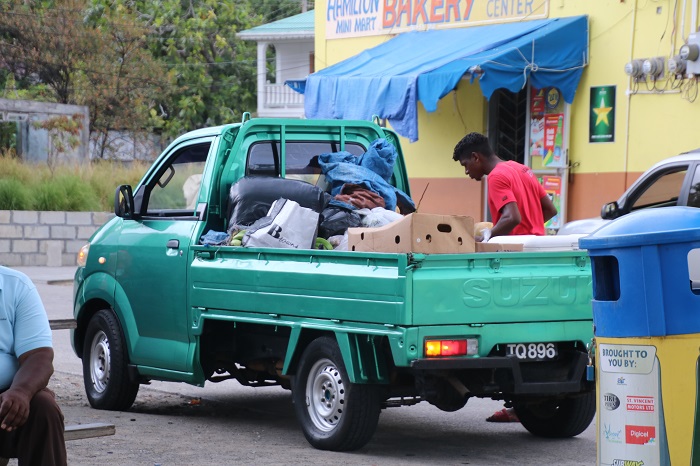 Well, I guess that’s about all for now, an odd mix of stuff to be sure. However, one thing that carries through, I hope, is that Bequia is the place to go if you are drawn to things made by people who take pride in their work. All that with the possible exception of a bird, a few yachts and an odd truck thrown in for good measure.
Well, I guess that’s about all for now, an odd mix of stuff to be sure. However, one thing that carries through, I hope, is that Bequia is the place to go if you are drawn to things made by people who take pride in their work. All that with the possible exception of a bird, a few yachts and an odd truck thrown in for good measure. And, speaking of varnish, which I was, she has plenty along with a large enough crew to keep up with it. I love the color of the boat, Columbia Grey, I am told. Pandora’s dark green is very hot in the tropical sun and we are considering having her repainted in Antigua, perhaps a medium grey. Changing her color is complicated and more expensive than just going with the same color again, so we’ll have to see what comes of that. I have lined up someone to do it when I get to Antigua in mid April but it’s unclear if there will be time to get the job done before I leave to head to New England in early May.
And, speaking of varnish, which I was, she has plenty along with a large enough crew to keep up with it. I love the color of the boat, Columbia Grey, I am told. Pandora’s dark green is very hot in the tropical sun and we are considering having her repainted in Antigua, perhaps a medium grey. Changing her color is complicated and more expensive than just going with the same color again, so we’ll have to see what comes of that. I have lined up someone to do it when I get to Antigua in mid April but it’s unclear if there will be time to get the job done before I leave to head to New England in early May.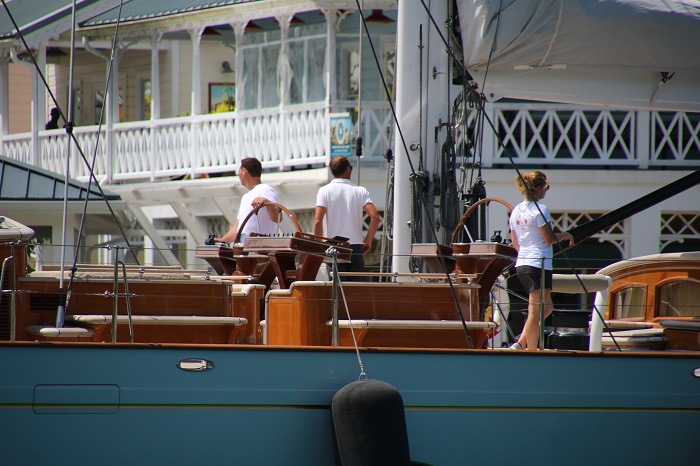 She looks enormous on the dock compared with Pandora out in the harbor.
She looks enormous on the dock compared with Pandora out in the harbor. 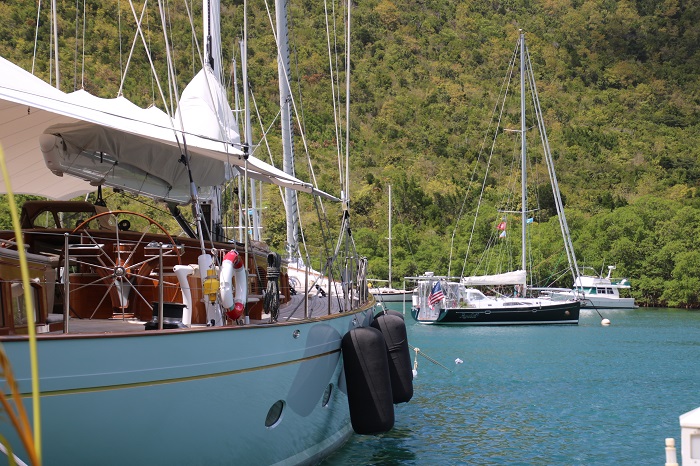 Just about everywhere you go in the southeast Caribbean, “boat boys” approach you selling something. This guy was selling bananas. We bought some and paid too much. He reminded us of the Grinch, in looks, not temperament.
Just about everywhere you go in the southeast Caribbean, “boat boys” approach you selling something. This guy was selling bananas. We bought some and paid too much. He reminded us of the Grinch, in looks, not temperament. 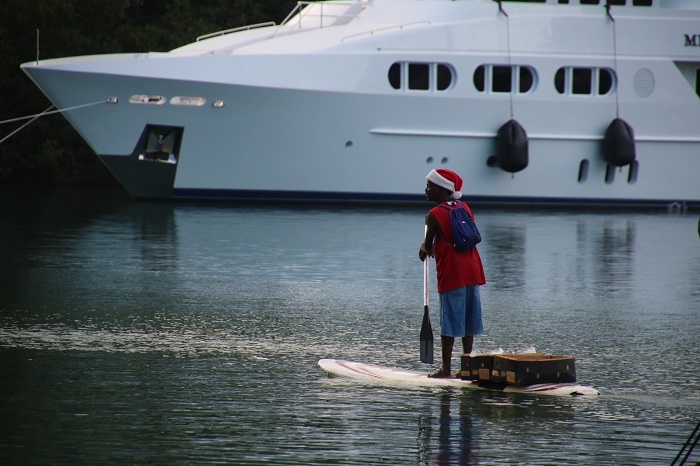 Across the harbor was a trail that led up to the top of the hill. I climbed up the impossibly steep trail, complete with installed ropes to hold as you pulled yourself up. I didn’t think I’d make it. Later I was told that many 20 somethings turn back because it’s so steep. Go me! Trust me, it was way, way steeper than it looks in this photo.
Across the harbor was a trail that led up to the top of the hill. I climbed up the impossibly steep trail, complete with installed ropes to hold as you pulled yourself up. I didn’t think I’d make it. Later I was told that many 20 somethings turn back because it’s so steep. Go me! Trust me, it was way, way steeper than it looks in this photo. At the top, after many stops to catch my breath along the way, I was told to look for the “meditation platform”. By the time I got there it looked more like a “recovery platform” to me, a place to lay down to listen to my pounding heart as it slowed to normal. Most of the time really steep paths have many switchbacks to make the climb easier. Not here.
At the top, after many stops to catch my breath along the way, I was told to look for the “meditation platform”. By the time I got there it looked more like a “recovery platform” to me, a place to lay down to listen to my pounding heart as it slowed to normal. Most of the time really steep paths have many switchbacks to make the climb easier. Not here. There’s little Pandora way down below.
There’s little Pandora way down below. 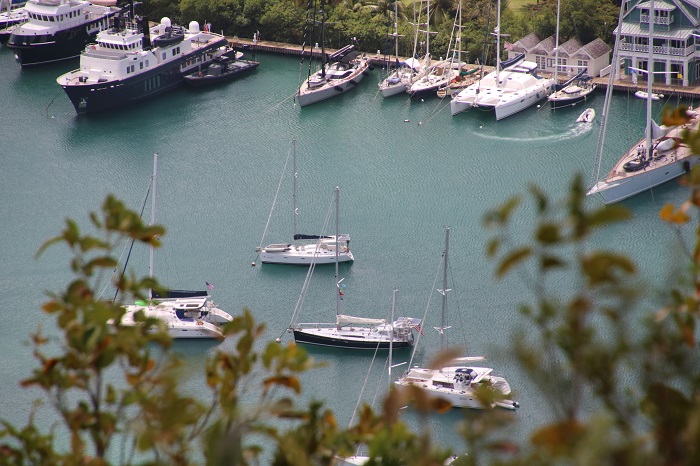 And the view south toward the Pitons, the short run to where we were headed the next day.
And the view south toward the Pitons, the short run to where we were headed the next day. 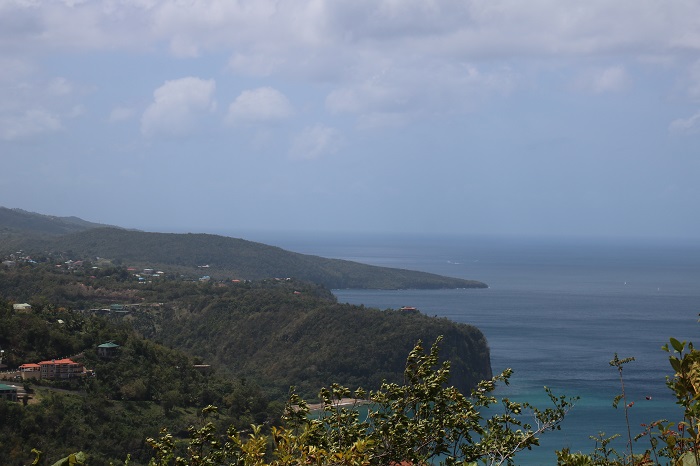 The Pitons, one of the most photographed sites in the Caribbean, are two 1,000′ tall cones from long extinct volcanoes. They are impossibly steep and the ocean drops off quickly to more than a mile deep very close to the shore.
The Pitons, one of the most photographed sites in the Caribbean, are two 1,000′ tall cones from long extinct volcanoes. They are impossibly steep and the ocean drops off quickly to more than a mile deep very close to the shore.  We took a mooring in 140′ because of the dropoff. I have never taken a mooring in that much water. The gusty winds swirled around us we swung one way or the other by 100′ or more because of the impossibly long scope on the mooring. It was gusty there, so close to the rising mountains so we had to get help from one of the local “boat boys” to tie up. As high as the “hill” looks, its actually a lot higher. As they say, “you had to be there”.
We took a mooring in 140′ because of the dropoff. I have never taken a mooring in that much water. The gusty winds swirled around us we swung one way or the other by 100′ or more because of the impossibly long scope on the mooring. It was gusty there, so close to the rising mountains so we had to get help from one of the local “boat boys” to tie up. As high as the “hill” looks, its actually a lot higher. As they say, “you had to be there”. 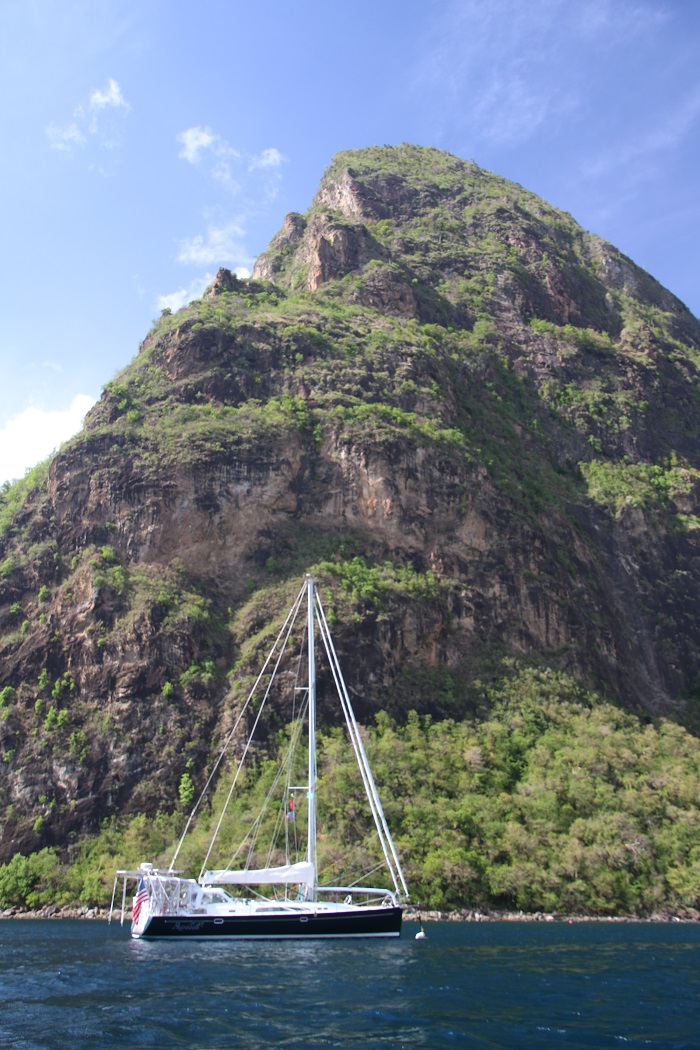 We headed ashore to a very fancy resort on the beach and enjoyed the setting sun from our table under the palms. It was a “million dollar view” and the bar tab was right in line. How about $100 for two glasses of wine each and a single appetizer?
We headed ashore to a very fancy resort on the beach and enjoyed the setting sun from our table under the palms. It was a “million dollar view” and the bar tab was right in line. How about $100 for two glasses of wine each and a single appetizer? 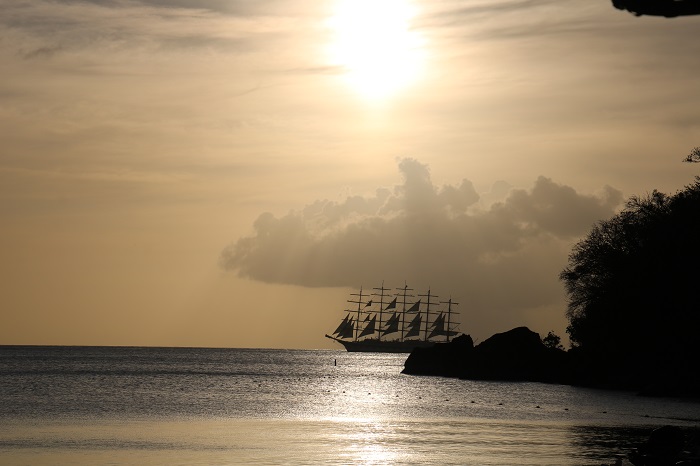 The next day we dropped the mooring first thing and headed south to Bequia. As we rounded the southern tip of St Lucia the seas were very confused with a strong western setting current pushing against us. That combined with the wind funneling around the headlands made for some pretty “sporty” conditions for the first hour. In spite of my having carefully secured the dink I was concerned about how much it was moving around in the davits. Fortunately, no damage.
The next day we dropped the mooring first thing and headed south to Bequia. As we rounded the southern tip of St Lucia the seas were very confused with a strong western setting current pushing against us. That combined with the wind funneling around the headlands made for some pretty “sporty” conditions for the first hour. In spite of my having carefully secured the dink I was concerned about how much it was moving around in the davits. Fortunately, no damage.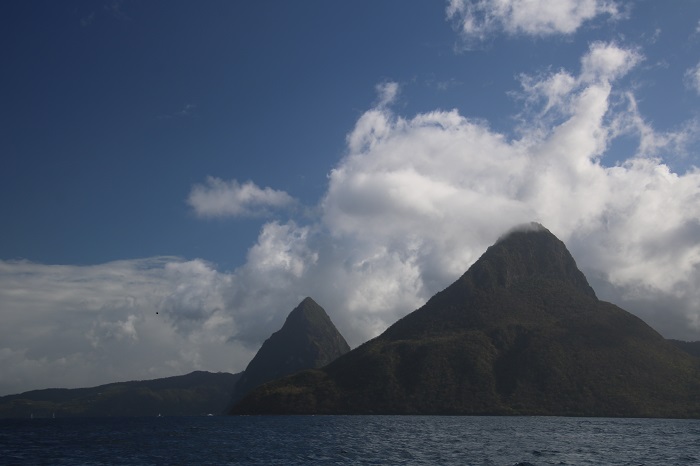 It was a long day, nearly 60 miles, as we could not stop in St Vincent, a large island just north of here as it’s not safe. Too bad that some bad actors have scared off all the cruisers.
It was a long day, nearly 60 miles, as we could not stop in St Vincent, a large island just north of here as it’s not safe. Too bad that some bad actors have scared off all the cruisers. 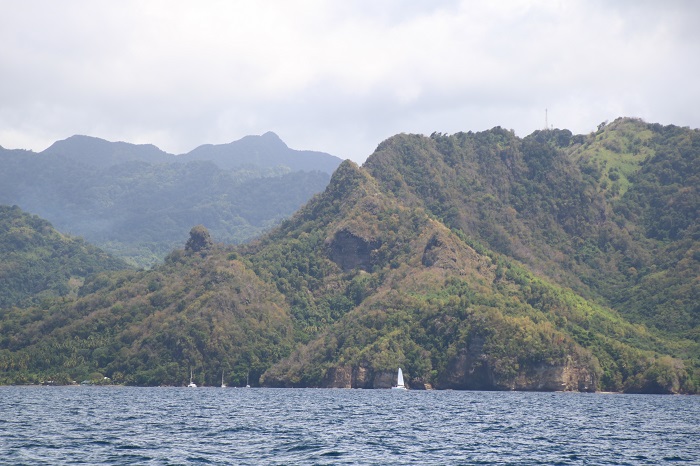 Bequia is truly an island of boaters and there is a very active junior sailing program with some really nice boats. They sailed right by us through the turquoise waters.
Bequia is truly an island of boaters and there is a very active junior sailing program with some really nice boats. They sailed right by us through the turquoise waters.  Heading back up wind, they looked like they were having a wonderful time. To me, this picture just speaks to the exuberance of kids out sailing for an afternoon as they tacked through the anchored boats.
Heading back up wind, they looked like they were having a wonderful time. To me, this picture just speaks to the exuberance of kids out sailing for an afternoon as they tacked through the anchored boats. 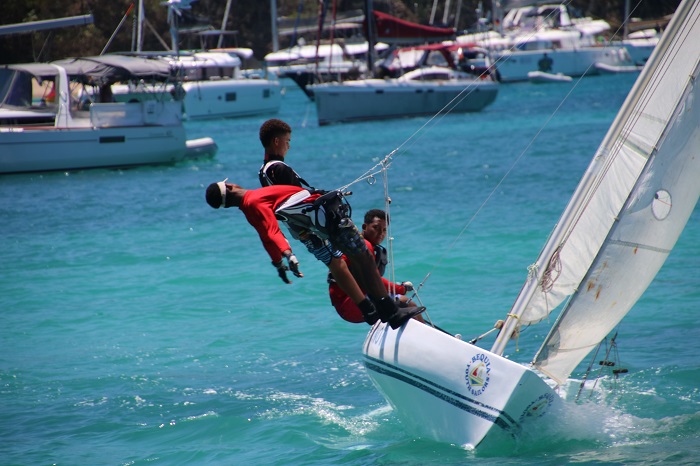 The customs house is right near the dinghy dock. Very Caribbean. True to form, with it’s English heritage, clearing in was much more complicated than the French islands.
The customs house is right near the dinghy dock. Very Caribbean. True to form, with it’s English heritage, clearing in was much more complicated than the French islands. Main street in the village is tree lined and very quaint.
Main street in the village is tree lined and very quaint. 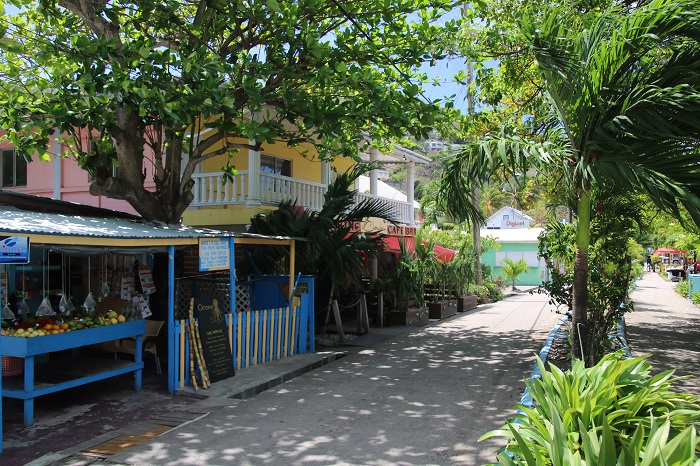 I liked this scruffy building framed in flowers.
I liked this scruffy building framed in flowers.  Everything here is very colorful, even the ferry boats lined up at the dock.
Everything here is very colorful, even the ferry boats lined up at the dock. 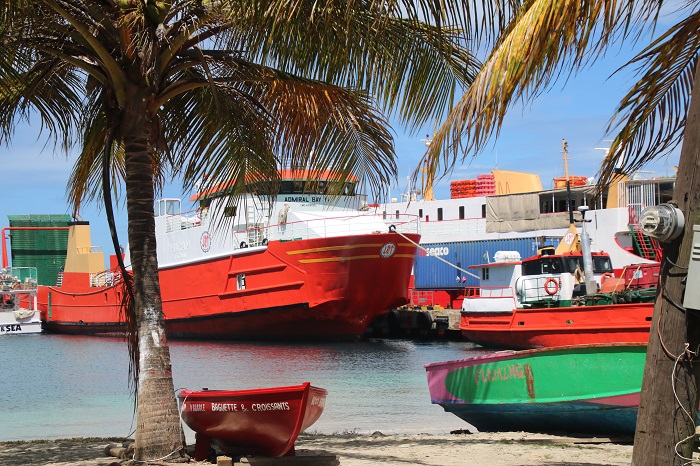 Well, I guess that’s about it for today. The WiFi is really slow and doing this post has taken me FOR EVER.
Well, I guess that’s about it for today. The WiFi is really slow and doing this post has taken me FOR EVER. And speaking of hustle, there are plenty of day boats taking large groups of tourists out for a day of snorkeling and sightseeing. A parade of these jam packed boats come through the harbor every day. I wonder if the USCG would approve of their safety equipment? Perhaps better not to ask.
And speaking of hustle, there are plenty of day boats taking large groups of tourists out for a day of snorkeling and sightseeing. A parade of these jam packed boats come through the harbor every day. I wonder if the USCG would approve of their safety equipment? Perhaps better not to ask. Ok, how about some boat watching? I love this little
Ok, how about some boat watching? I love this little  Perhaps something with a bit more creature comfort is what you’re looking for. RH3 is a beautiful explorer yacht that went through a major refit just a few years ago. She’s rugged and looks the part of a world cruiser, which she is.
Perhaps something with a bit more creature comfort is what you’re looking for. RH3 is a beautiful explorer yacht that went through a major refit just a few years ago. She’s rugged and looks the part of a world cruiser, which she is.  Her tenders are impressive and this one, that I guess they must tow around, would fit right in a James Bond movie. And, that doesn’t even count the two smaller equally sinister looking ones parked on the upper deck. His and hers?
Her tenders are impressive and this one, that I guess they must tow around, would fit right in a James Bond movie. And, that doesn’t even count the two smaller equally sinister looking ones parked on the upper deck. His and hers? I am particularly struck by this Lefite 44. She is an 80s vintage and yet doesn’t look it as her owner has lovingly maintained her, along with some excellent craftsmen in Trinidad where she has been stored for a number of summer seasons. She must be the best of her breed and I understand that she’s for sale. Bob Perry, perhaps the leading designer of cruising boats, designed her back in 1978.
I am particularly struck by this Lefite 44. She is an 80s vintage and yet doesn’t look it as her owner has lovingly maintained her, along with some excellent craftsmen in Trinidad where she has been stored for a number of summer seasons. She must be the best of her breed and I understand that she’s for sale. Bob Perry, perhaps the leading designer of cruising boats, designed her back in 1978. 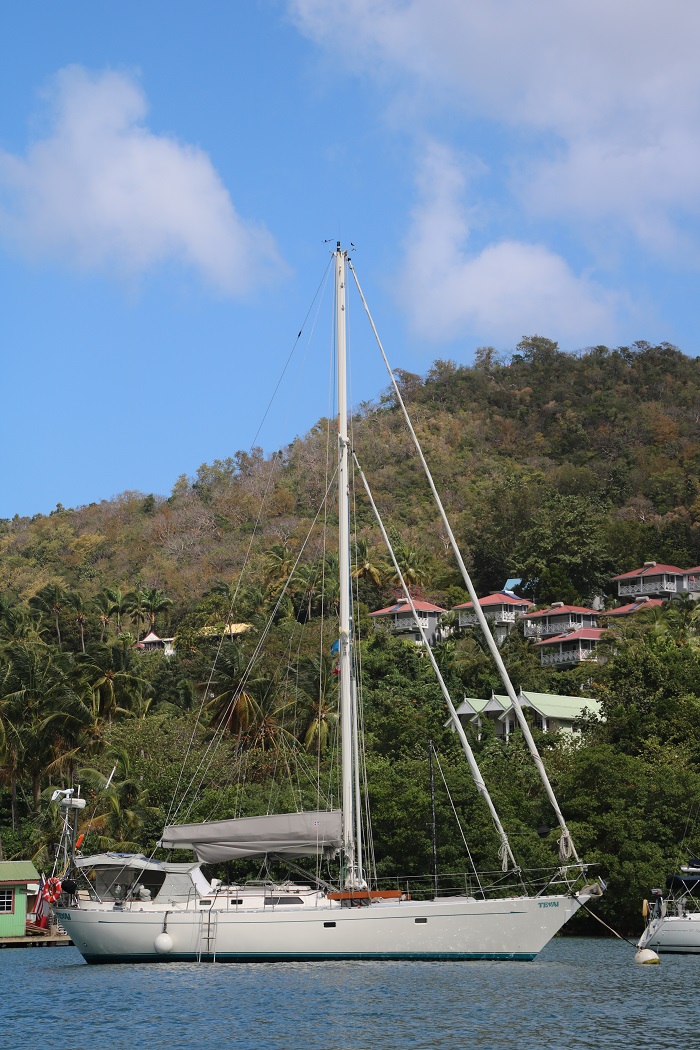 And speaking of nice boats. How about Pandora sitting pretty in this tiny charming harbor?
And speaking of nice boats. How about Pandora sitting pretty in this tiny charming harbor?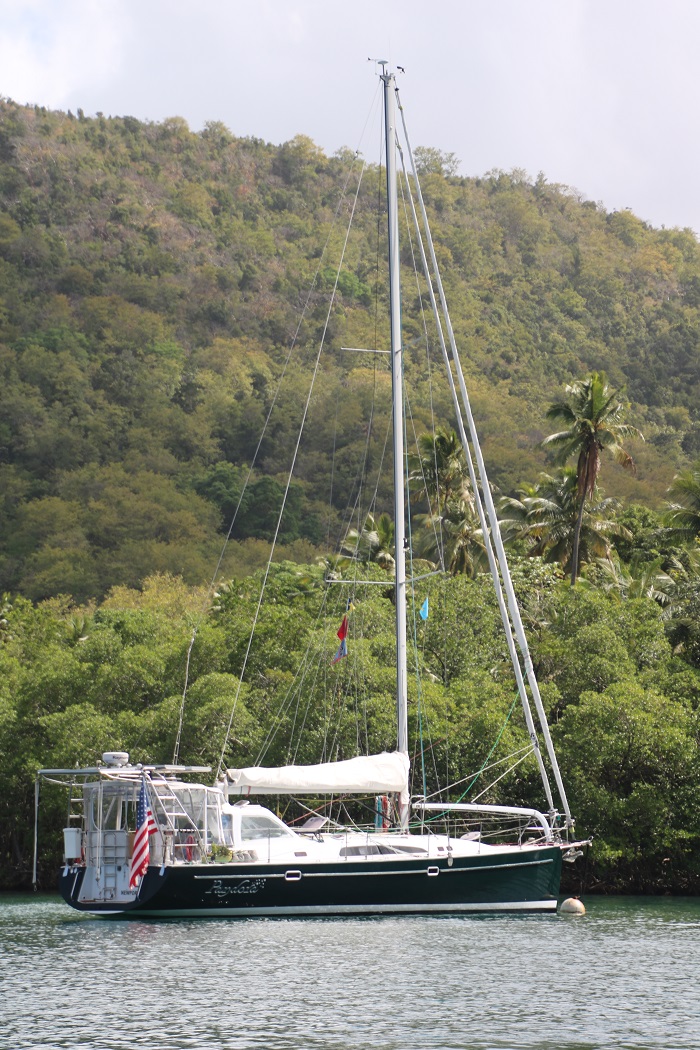 Well, it’s almost lunchtime and, as usual, not a lot has happened aboard Pandroa so I’d better, as my father used to say, “get the lead out”. Actually, I have to clear out today so we can leave in the morning for the Pitons and then on to Bequia.
Well, it’s almost lunchtime and, as usual, not a lot has happened aboard Pandroa so I’d better, as my father used to say, “get the lead out”. Actually, I have to clear out today so we can leave in the morning for the Pitons and then on to Bequia.  We left shortly after sunrise to make the run down the coast. We had a short, less than 10 mile run before turning into Marigot. The western coast of St Lucia is very green and lush.
We left shortly after sunrise to make the run down the coast. We had a short, less than 10 mile run before turning into Marigot. The western coast of St Lucia is very green and lush. 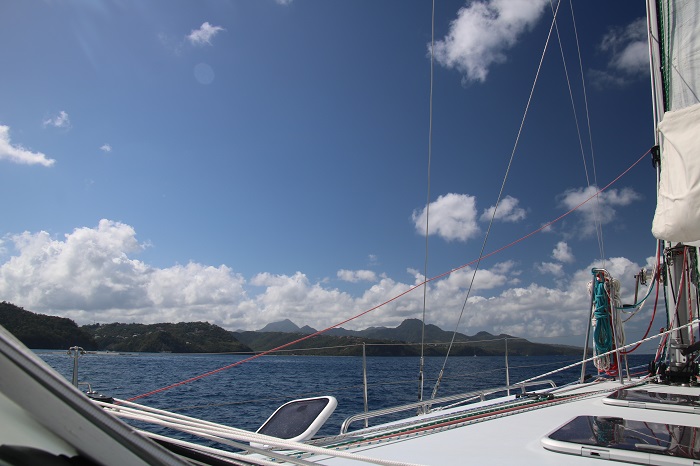 The outer harbor of Marigot is quite narrow and mostly too deep to anchor, however, you can anchor along the side near shore in less than 20′. There is a beautiful stand of palms along the spit that protects the inner harbor. They framed the view that greeted me this morning in the early light. The wind and water were uncharacteristically still. Those palms really make the place look remote and plenty tropical, like a south seas village.
The outer harbor of Marigot is quite narrow and mostly too deep to anchor, however, you can anchor along the side near shore in less than 20′. There is a beautiful stand of palms along the spit that protects the inner harbor. They framed the view that greeted me this morning in the early light. The wind and water were uncharacteristically still. Those palms really make the place look remote and plenty tropical, like a south seas village.  However, it’s not remote at all with the really lux,
However, it’s not remote at all with the really lux, 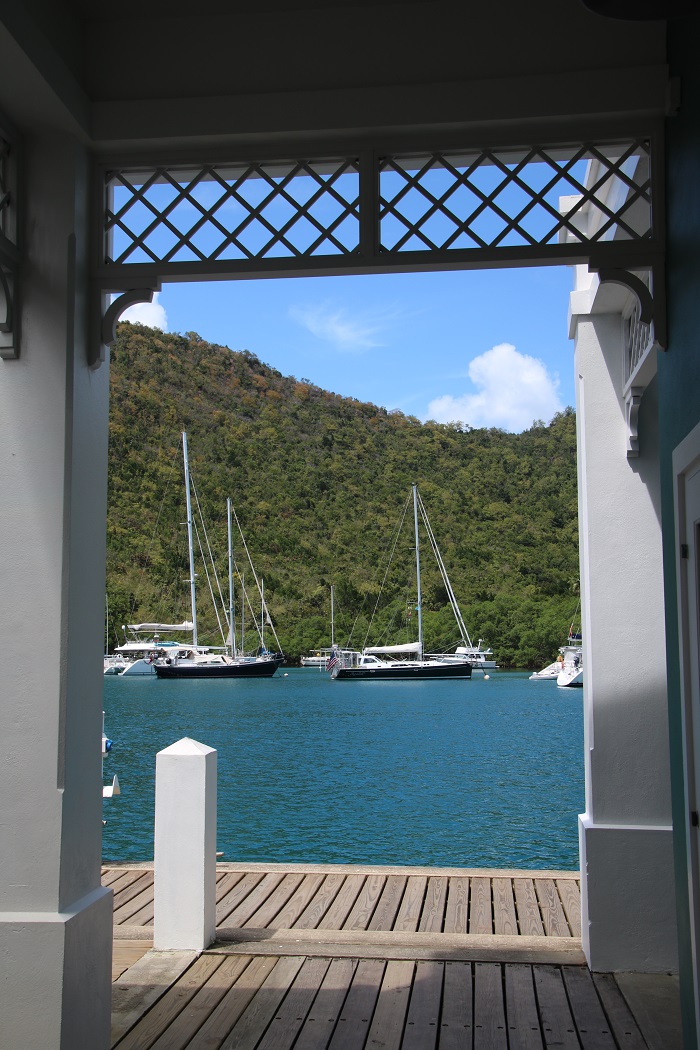 There are actually a number of restaurants to choose from, some alongside infinity pools and many of the rooms have their own mini-pool just outside the room.
There are actually a number of restaurants to choose from, some alongside infinity pools and many of the rooms have their own mini-pool just outside the room.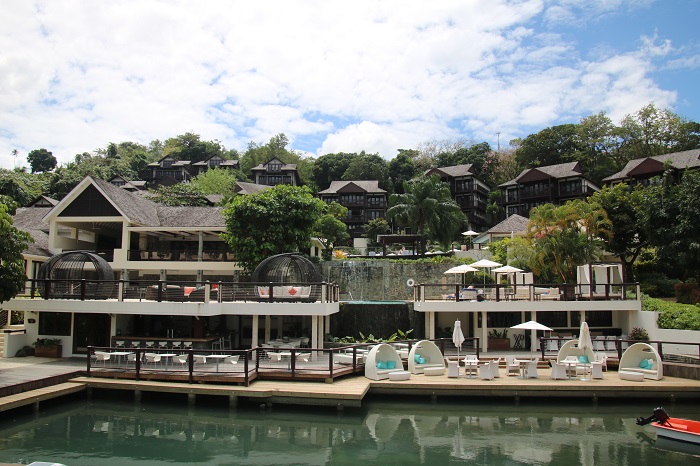 One cascades into the other.
One cascades into the other. 
 If all this isn’t in your budget, you can always go next door and get your hair cut.
If all this isn’t in your budget, you can always go next door and get your hair cut. 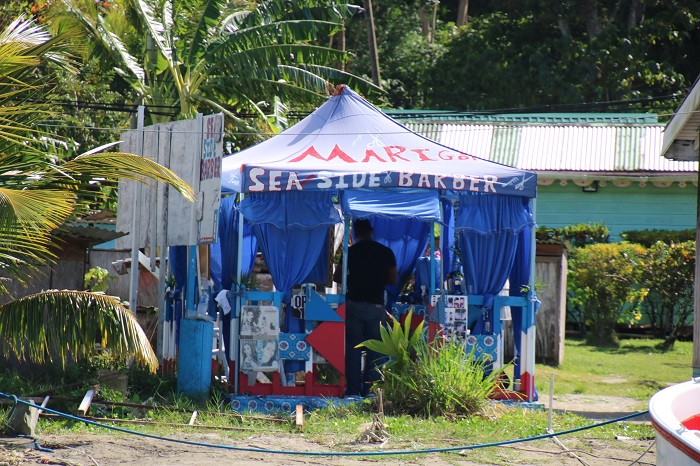 Want to rent a small boat yourself. There’s plenty to choose from on the waterfront.
Want to rent a small boat yourself. There’s plenty to choose from on the waterfront. 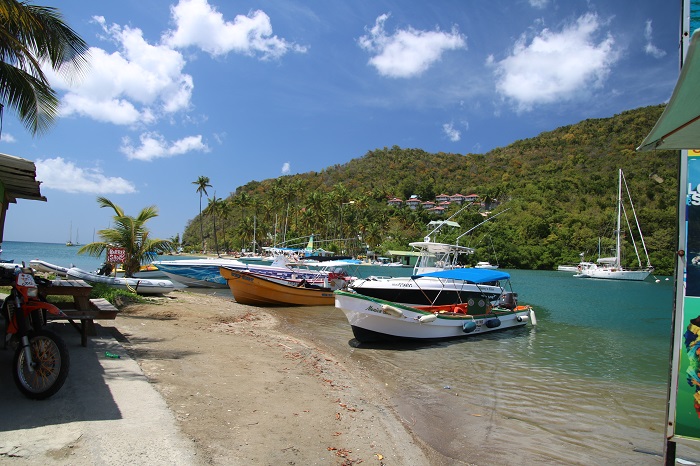 However, most of the residents, and some of them are particularly well heeled, probably keep their own barber on board. Tommy Hilfiger’s yacht, Flag pulled in yesterday. It was amazing to see such a huge yacht navigate in this tiny teacup harbor and pull up to the dock. They do advertise as being able to handle yachts up to 250′ long and Flag is nearly that big. I realized that it was Hilfiger’s yacht because his “corporate” flag logo was on the side of the superstructure. After a bit of digging, I confirmed it. It’s amazing what you can find on the Internet.
However, most of the residents, and some of them are particularly well heeled, probably keep their own barber on board. Tommy Hilfiger’s yacht, Flag pulled in yesterday. It was amazing to see such a huge yacht navigate in this tiny teacup harbor and pull up to the dock. They do advertise as being able to handle yachts up to 250′ long and Flag is nearly that big. I realized that it was Hilfiger’s yacht because his “corporate” flag logo was on the side of the superstructure. After a bit of digging, I confirmed it. It’s amazing what you can find on the Internet.  That ketch is a mere 200′ long. Not too shabby.
That ketch is a mere 200′ long. Not too shabby.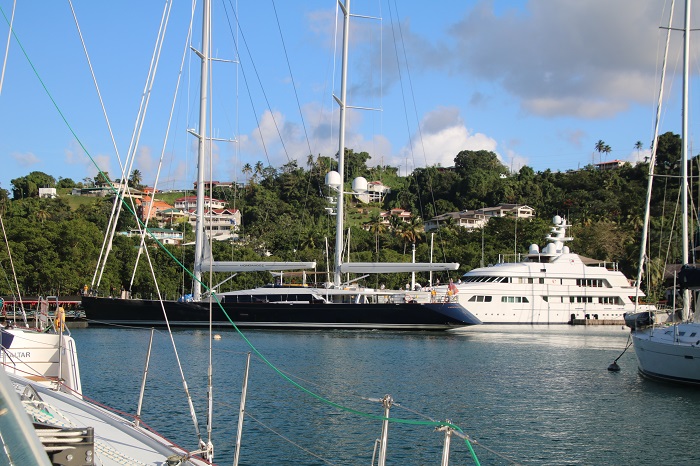 Atlante, another resident here when we arrived yesterday, is much smaller at only a tad over 100 feet and is only a few years old. She’s spectacular.
Atlante, another resident here when we arrived yesterday, is much smaller at only a tad over 100 feet and is only a few years old. She’s spectacular. 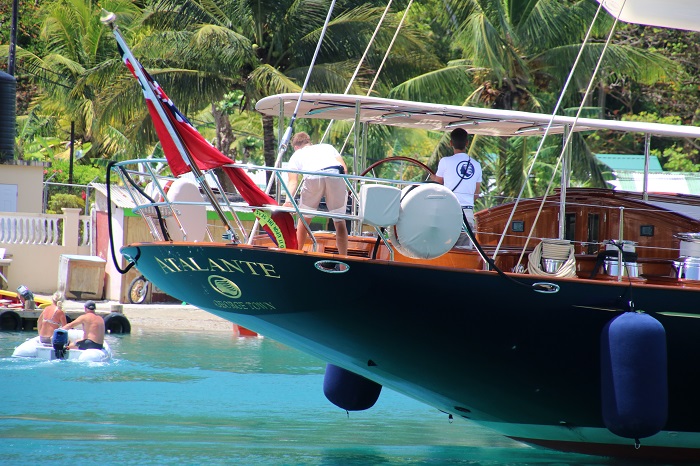 Yes, this is a pretty rarefied neighborhood and it’s going to be tough to pry ourselves away. It’s supposed to get fairly windy for a few days so perhaps we will just have to hang out here for a bit and then move further south.
Yes, this is a pretty rarefied neighborhood and it’s going to be tough to pry ourselves away. It’s supposed to get fairly windy for a few days so perhaps we will just have to hang out here for a bit and then move further south.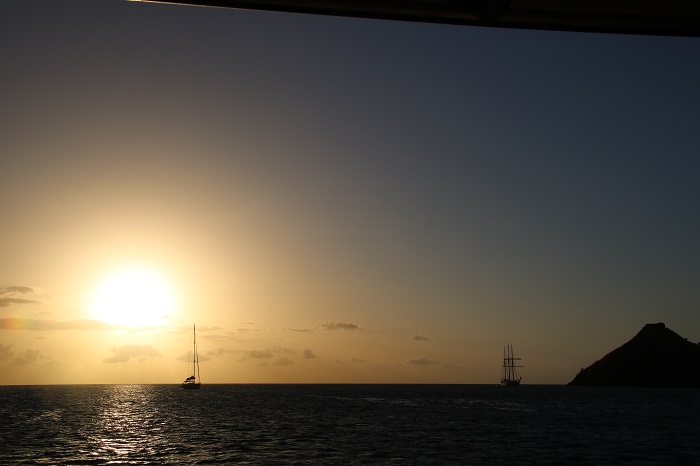 A square rigger ablaze with lights in the twilight.
A square rigger ablaze with lights in the twilight. 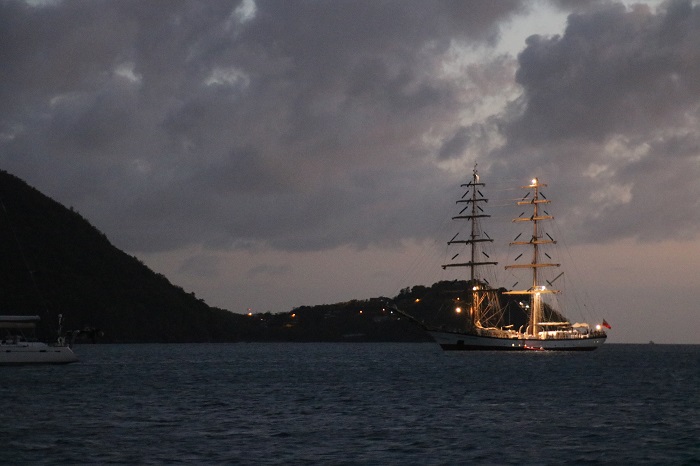 We’ve been here for two days and plan to leave in the morning to head down-island to the Pitons, perhaps one of the most photographed places in the Caribbean. After that, we will head to Bequia to rejoin a few of our cruising friends for a few days relaxing in what some say is their favorite island in the chain.
We’ve been here for two days and plan to leave in the morning to head down-island to the Pitons, perhaps one of the most photographed places in the Caribbean. After that, we will head to Bequia to rejoin a few of our cruising friends for a few days relaxing in what some say is their favorite island in the chain. The view south toward the Pitons and a schooner heading out.
The view south toward the Pitons and a schooner heading out. 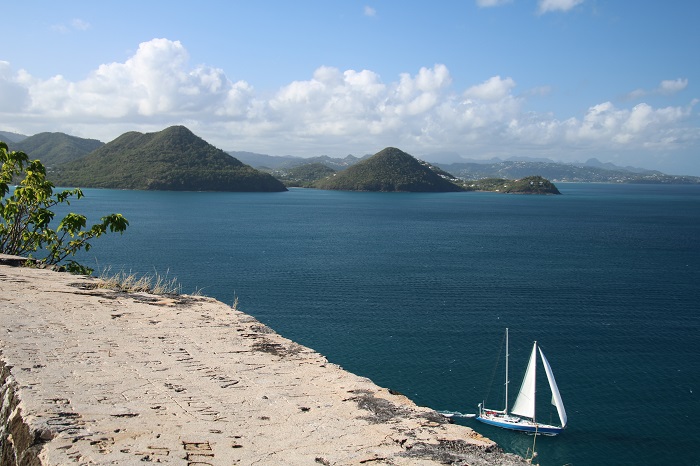 This harbor was an important stronghold for the British during the 17th and 18th centuries. Nearby Martinique, which is easily seen from the fort lookout, was an important port for the French so keeping watch afforded a good view of any impending attack.
This harbor was an important stronghold for the British during the 17th and 18th centuries. Nearby Martinique, which is easily seen from the fort lookout, was an important port for the French so keeping watch afforded a good view of any impending attack.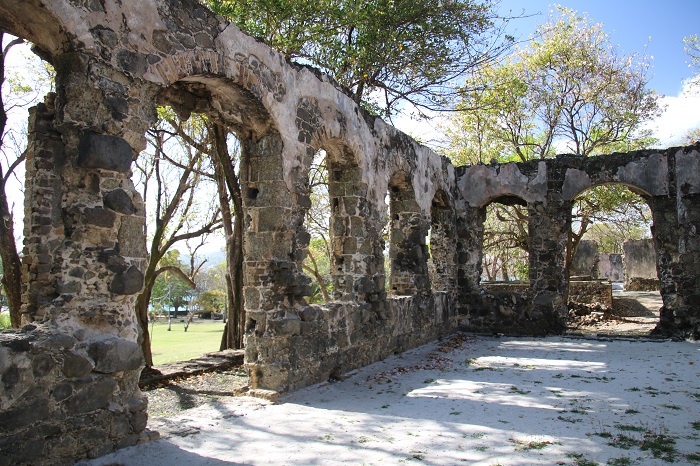 When we returned from our hike a fruit and vegetable vendor came to visit in his “eclectic” store.
When we returned from our hike a fruit and vegetable vendor came to visit in his “eclectic” store. 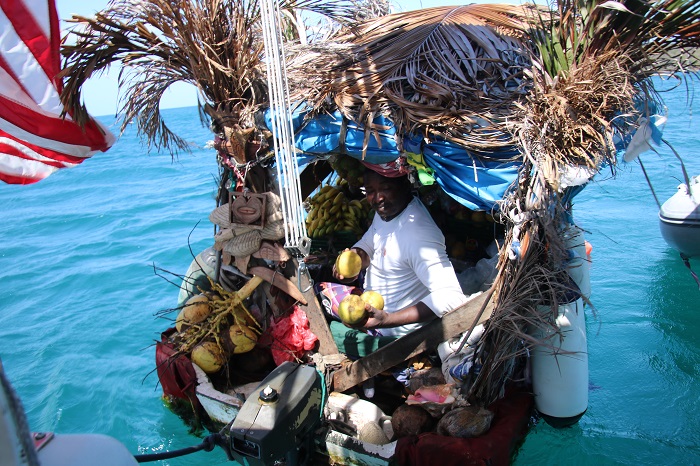 We bought a variety of produce including this huge and very lumpy lemon. The produce looked pretty rough compared to what we see in US markets but I expect that what it lacks in good looks will be made up by great taste. In the US we sometimes forget what local is supposed to look like.
We bought a variety of produce including this huge and very lumpy lemon. The produce looked pretty rough compared to what we see in US markets but I expect that what it lacks in good looks will be made up by great taste. In the US we sometimes forget what local is supposed to look like. 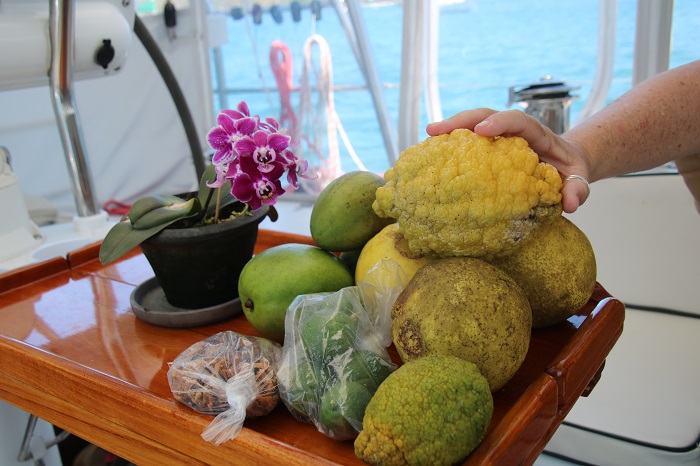 As I headed in to do some errands and this post, I passed a lovely gaff rigged sloop plying the blue waters of the harbor.
As I headed in to do some errands and this post, I passed a lovely gaff rigged sloop plying the blue waters of the harbor.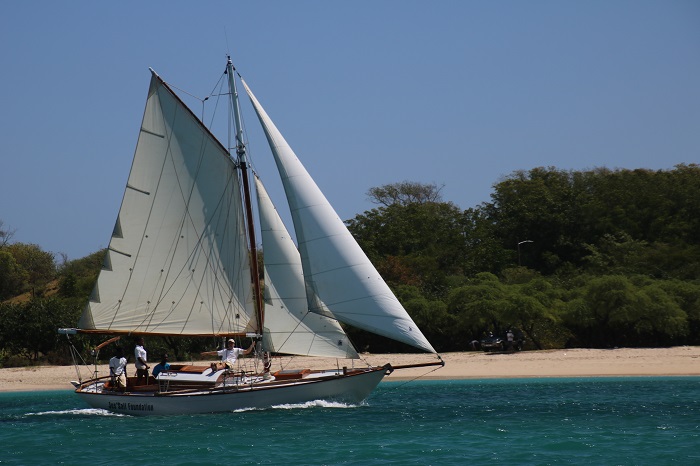 Well, it’s taken a lot longer to do this post than it should have thanks to really, really SLOOOOW Wifi. I had to try two different spots until I found a spot where the speed was, sort of, OK. It seems that mid day is just too busy with lots of folks competing for time on the server and everything just slows to a crawl.
Well, it’s taken a lot longer to do this post than it should have thanks to really, really SLOOOOW Wifi. I had to try two different spots until I found a spot where the speed was, sort of, OK. It seems that mid day is just too busy with lots of folks competing for time on the server and everything just slows to a crawl. It is hard to overstate the importance of the Caribbean sugar industry in the 17th and 18th centuries. During this period, the tiny island of Barbados had exports of sugar that were more valuable than the entire export income of North America. Great fortunes were made and lost along with a great human toll on both blacks and whites that died in great numbers in these islands.
It is hard to overstate the importance of the Caribbean sugar industry in the 17th and 18th centuries. During this period, the tiny island of Barbados had exports of sugar that were more valuable than the entire export income of North America. Great fortunes were made and lost along with a great human toll on both blacks and whites that died in great numbers in these islands. Bougainvillea climb each corner of the massive home.
Bougainvillea climb each corner of the massive home. 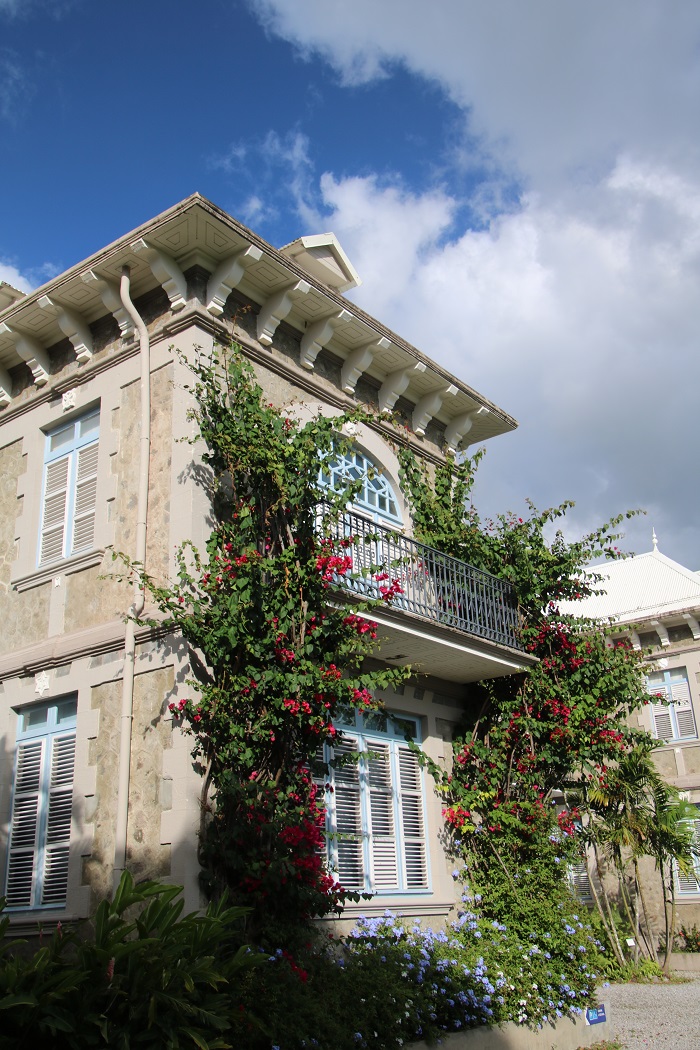 The gardens would have been the envy of any European aristocrat. No wait, these were European aristocrats.
The gardens would have been the envy of any European aristocrat. No wait, these were European aristocrats.  Nice view.
Nice view.  Immediately adjacent to the home is the modern production facility.
Immediately adjacent to the home is the modern production facility. 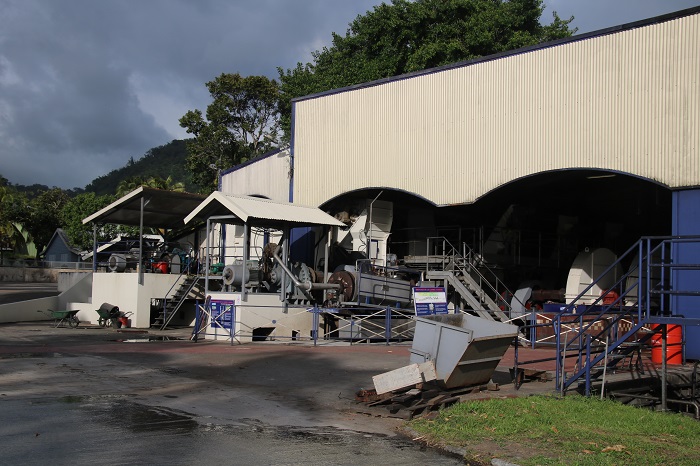 There are many buildings in the complex.
There are many buildings in the complex.  Including the reception center and tasting room. Unfortunately, they closed before we got there. However, I was able to beg them to let me in so I could buy a bottle to have my own tasting.
Including the reception center and tasting room. Unfortunately, they closed before we got there. However, I was able to beg them to let me in so I could buy a bottle to have my own tasting. 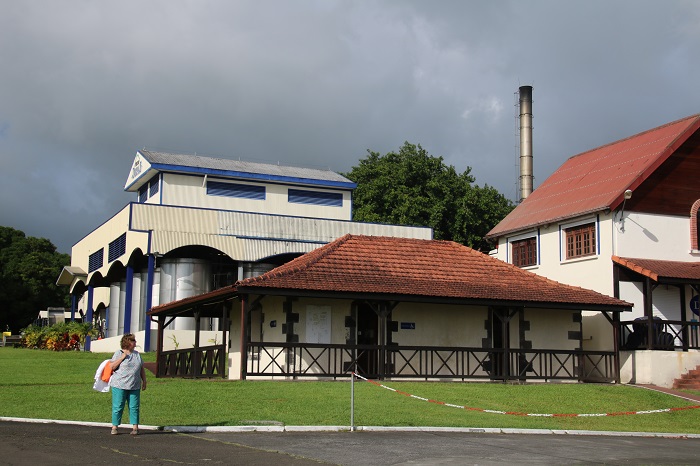 While the modern equipment is powered by electricity, water was once the primary driver of the machinery that processed the cane which had to be cut and crushed quickly to avoid premature fermenting in the tropical heat.
While the modern equipment is powered by electricity, water was once the primary driver of the machinery that processed the cane which had to be cut and crushed quickly to avoid premature fermenting in the tropical heat. 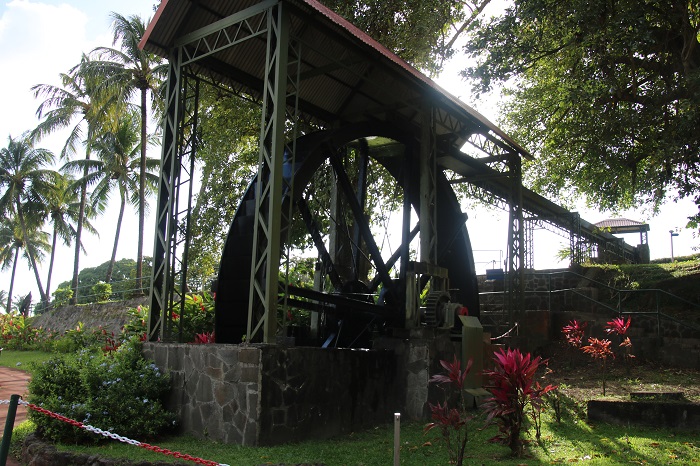 There are still remnants of the aqueducts that moved water to the factory. As Martinique is a very wet country, there is usually plenty of water and this spillway was designed to carry away excess water beyond what the factory needed to power the crushing machinery. The day we were there plenty of water was flowing over the spillway and onto the parking lot.
There are still remnants of the aqueducts that moved water to the factory. As Martinique is a very wet country, there is usually plenty of water and this spillway was designed to carry away excess water beyond what the factory needed to power the crushing machinery. The day we were there plenty of water was flowing over the spillway and onto the parking lot.  Modern equipment now does the backbreaking work that once took hundreds of slaves.
Modern equipment now does the backbreaking work that once took hundreds of slaves. 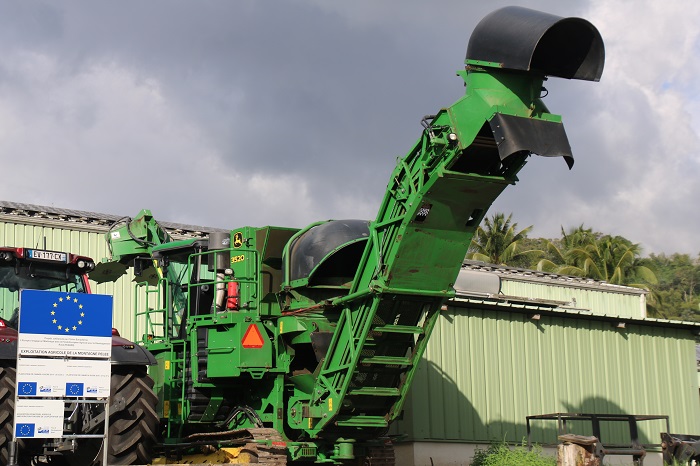 This is the business end of the combine. The boom at the top employs two massive circular blades to cut the cane and feed it into the steel “maws”. inside the machine the cane is chopped up and separated from the leaves that are spit out the back to help rebuild the soil. This is not a machine to be trifled with.
This is the business end of the combine. The boom at the top employs two massive circular blades to cut the cane and feed it into the steel “maws”. inside the machine the cane is chopped up and separated from the leaves that are spit out the back to help rebuild the soil. This is not a machine to be trifled with.  After visiting Depaz, we headed to the coast and St Pierre. Today the city is a popular tourist stop and no longer the capitol of the island. The local beaches are black volcanic sand and provide an gentle arc along the coast to the north.
After visiting Depaz, we headed to the coast and St Pierre. Today the city is a popular tourist stop and no longer the capitol of the island. The local beaches are black volcanic sand and provide an gentle arc along the coast to the north. 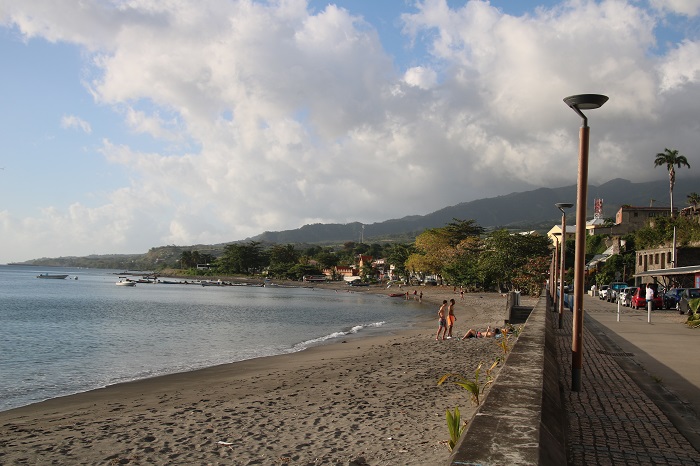 And south…
And south… Main street is lined with small shops and restaurants.
Main street is lined with small shops and restaurants.  Remnants of the once capitol buildings are preserved as a reminder of the power of the volcano. Unlike Montserrat, Pelee is currently dormant and scientists constantly monitor it for activity.
Remnants of the once capitol buildings are preserved as a reminder of the power of the volcano. Unlike Montserrat, Pelee is currently dormant and scientists constantly monitor it for activity. 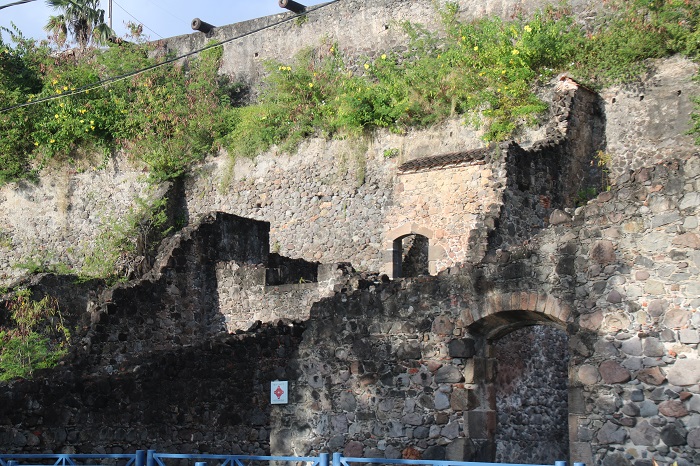 Today’s buildings still retain the charm of what might be called simpler times.
Today’s buildings still retain the charm of what might be called simpler times.  Unfortunately, we were late and many of the businesses were closed but it was nice to visit. Many boats were anchored off of the beach, including Ishtar, sister ship to our last Pandora, our SAGA 43.
Unfortunately, we were late and many of the businesses were closed but it was nice to visit. Many boats were anchored off of the beach, including Ishtar, sister ship to our last Pandora, our SAGA 43. 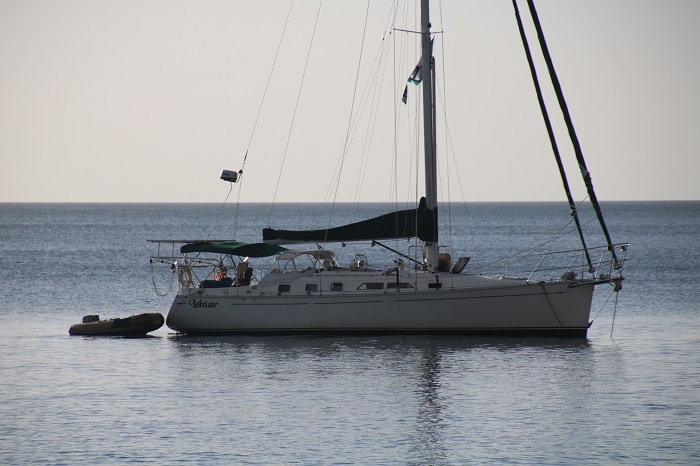 Perhaps we will visit aboard Pandora on a future trip through the islands.
Perhaps we will visit aboard Pandora on a future trip through the islands.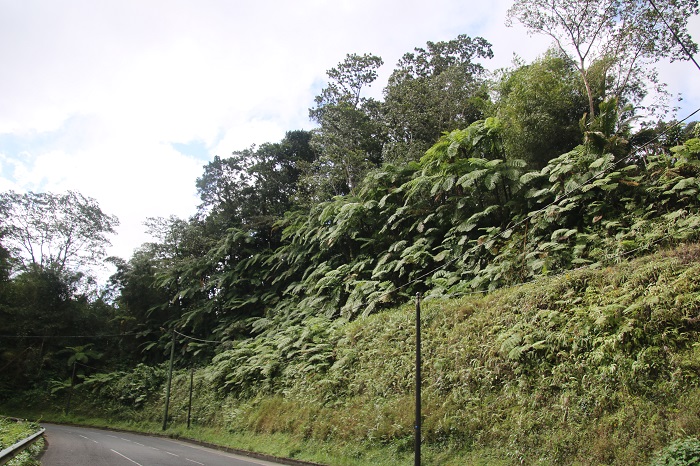 It was great fun driving along, white knuckles and all, making what seemed like impossible turns as the road made it’s way through the mountainous terrain. Suddenly, around yet another sharp bend in the road, we came upon a quick moving stream. It was beautiful.
It was great fun driving along, white knuckles and all, making what seemed like impossible turns as the road made it’s way through the mountainous terrain. Suddenly, around yet another sharp bend in the road, we came upon a quick moving stream. It was beautiful.  The waters rushing down from the mountains was crystal clear and wonderfully cool. A bit farther up from the road was a family lounging in the river.
The waters rushing down from the mountains was crystal clear and wonderfully cool. A bit farther up from the road was a family lounging in the river. 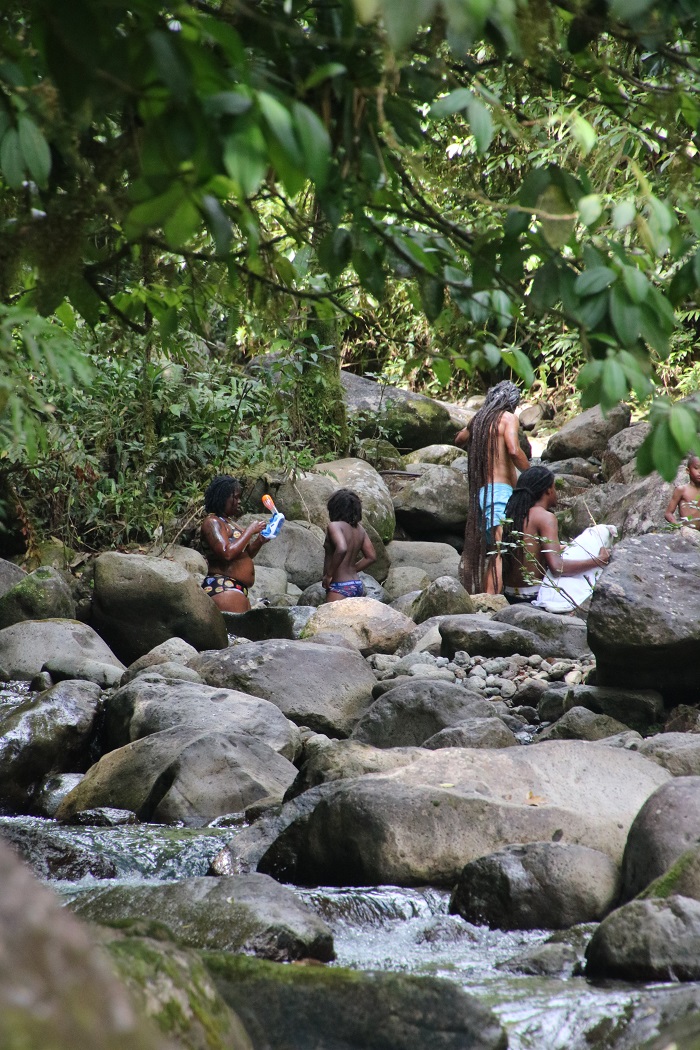 One bather had impossibly long hair, reaching to the ground. I’ll bet that he has wicked split ends. I wonder if his hair was as long as our granddaughter Tori when he was born.
One bather had impossibly long hair, reaching to the ground. I’ll bet that he has wicked split ends. I wonder if his hair was as long as our granddaughter Tori when he was born.  At most any point along the way Pelee was in view, towering over the landscape, shrouded in fog.
At most any point along the way Pelee was in view, towering over the landscape, shrouded in fog. 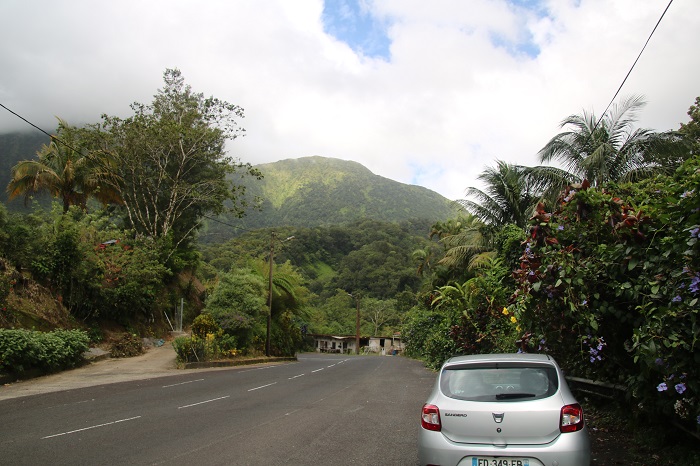 As we approached the summit by road the view, well, there wasn’t a view. I guess that’s why they call it a “cloud forest”.
As we approached the summit by road the view, well, there wasn’t a view. I guess that’s why they call it a “cloud forest”. 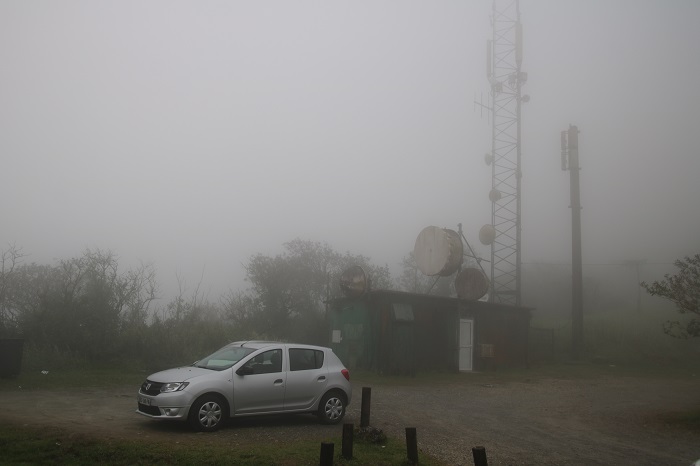 Along the way we happened upon
Along the way we happened upon 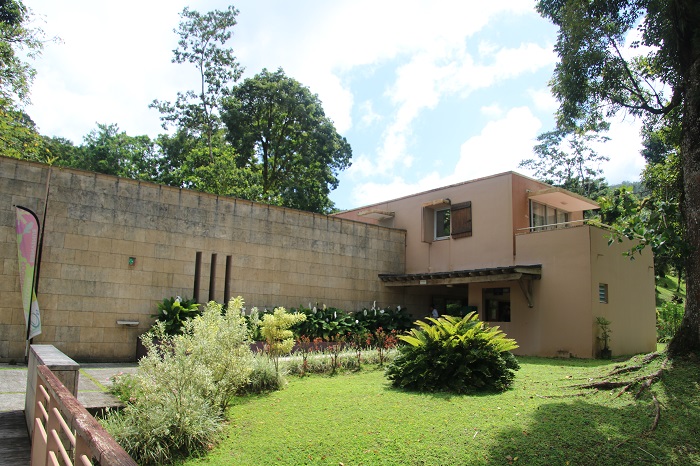 On site was an interpretative museum of the natural history of the island. Unfortunately, like their website, all the information was in French but well done. A beautiful setting.
On site was an interpretative museum of the natural history of the island. Unfortunately, like their website, all the information was in French but well done. A beautiful setting.  Reflecting pools lined the front of the building.
Reflecting pools lined the front of the building. 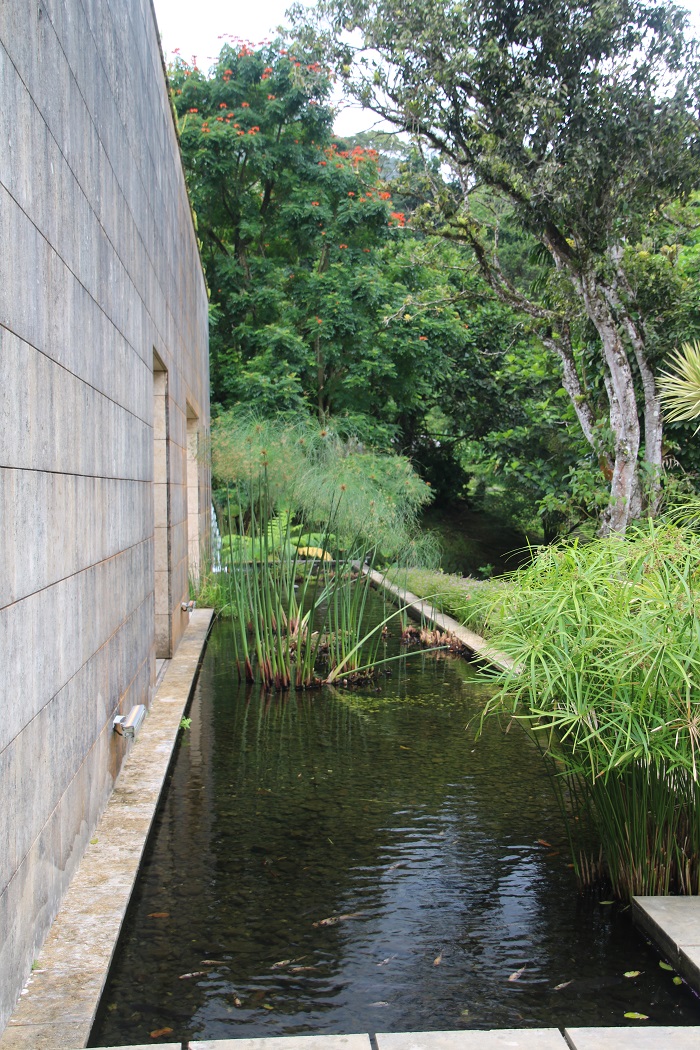 As y0u entered the building you were greeted by a beautifully displayed 3D map of the island, displayed under glass on the floor. It was a bit unnerving to stand on the glass.
As y0u entered the building you were greeted by a beautifully displayed 3D map of the island, displayed under glass on the floor. It was a bit unnerving to stand on the glass. 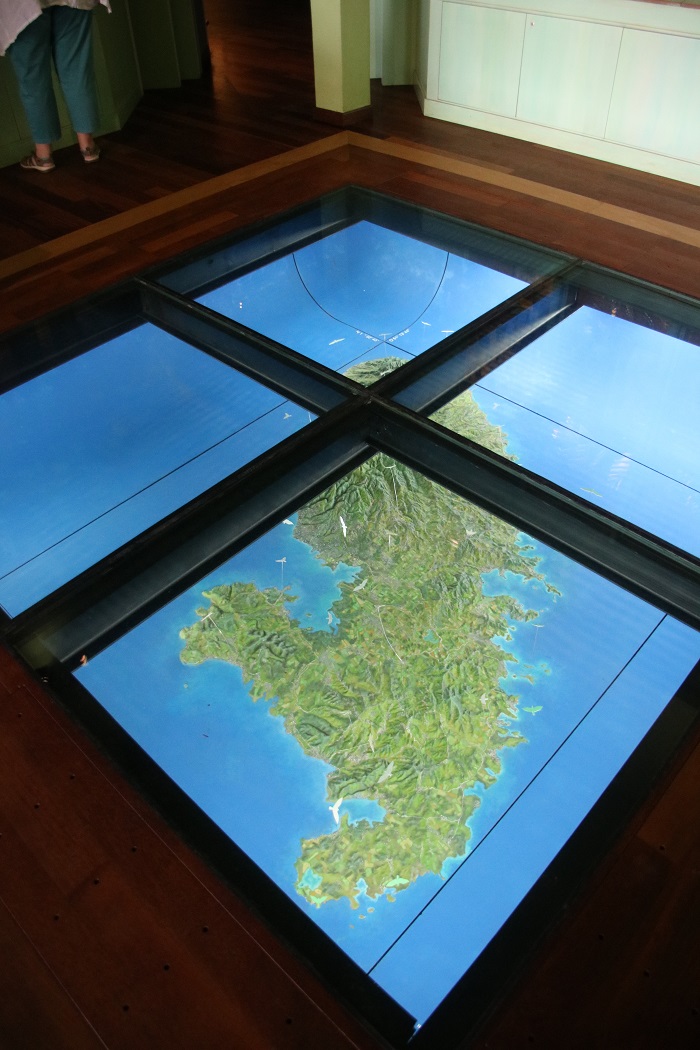 The manicured grounds surrounding the main buildings were beautifully presented.
The manicured grounds surrounding the main buildings were beautifully presented. 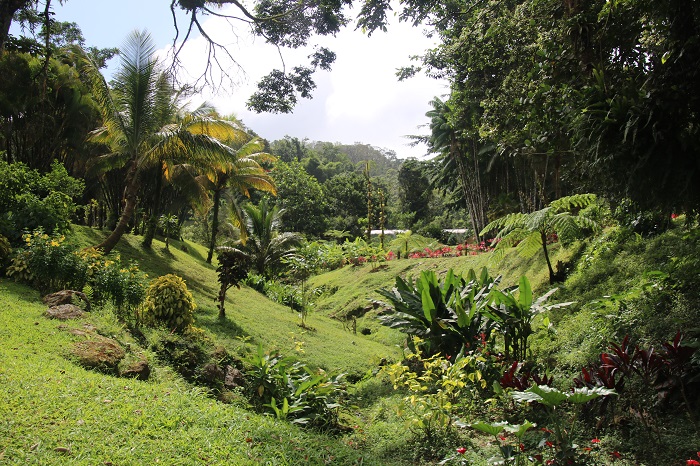 Beyond the organized parts of the preserve were miles of trails, every inch paved with cement slabs. I was told that the bags of concrete were carried in by hand and cast in place. In spite of the near constant moisture the rough surface of the path offered sure footing. I can not imagine the number of workers that it took to lay all of the pathways beginning in the 1970s, I believe.
Beyond the organized parts of the preserve were miles of trails, every inch paved with cement slabs. I was told that the bags of concrete were carried in by hand and cast in place. In spite of the near constant moisture the rough surface of the path offered sure footing. I can not imagine the number of workers that it took to lay all of the pathways beginning in the 1970s, I believe.  Some areas along the pathways offered dramatic views.
Some areas along the pathways offered dramatic views.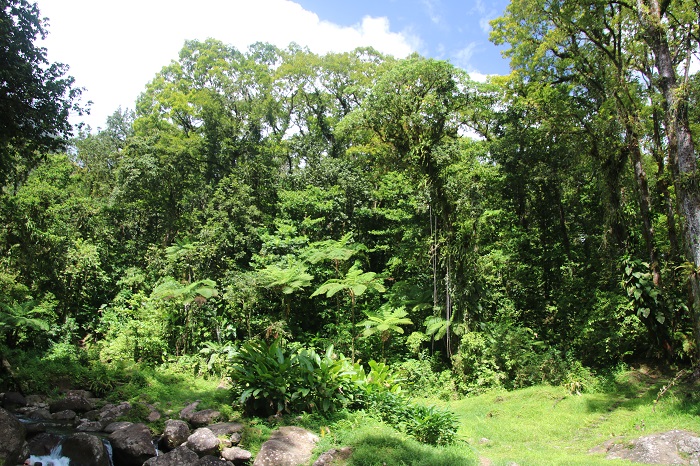 More often than not, the jungle was thick and you could see only a short distance.
More often than not, the jungle was thick and you could see only a short distance.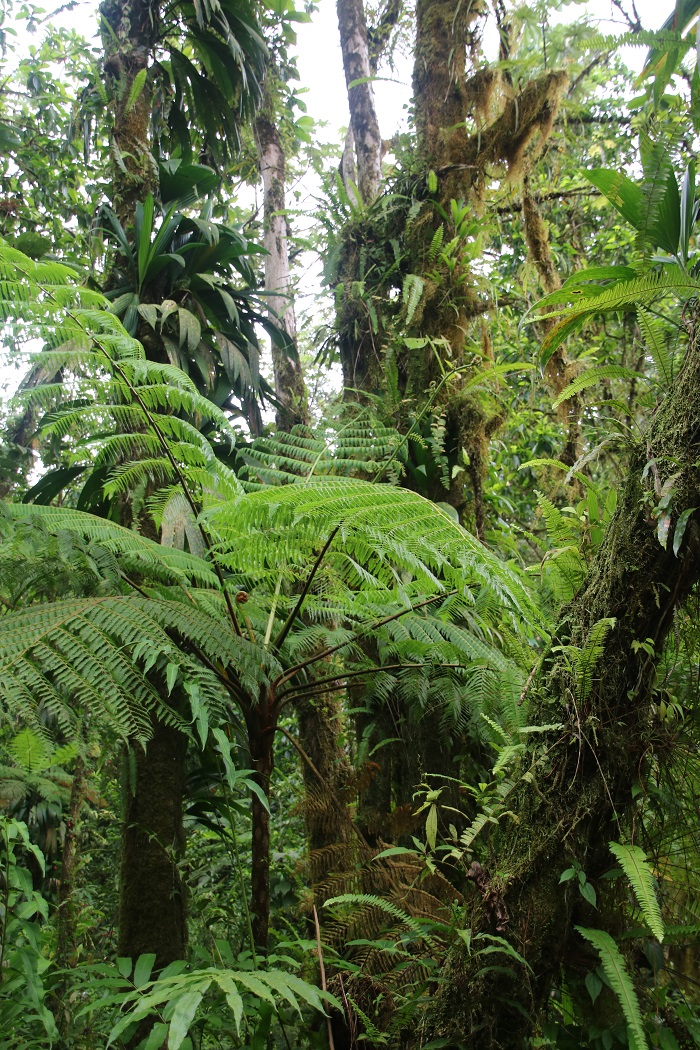 I just loved the giant ferns that were everywhere, some 40′ tall.
I just loved the giant ferns that were everywhere, some 40′ tall.  There are many species of orchids in the forest. Most grow hundreds of feet up in the treetop canopy but some thrive in the deep shade on the forest floor.
There are many species of orchids in the forest. Most grow hundreds of feet up in the treetop canopy but some thrive in the deep shade on the forest floor. This one, I believe is pollinated by a moth at night and has a strong sweet scent in the evening.
This one, I believe is pollinated by a moth at night and has a strong sweet scent in the evening.  This orchid’s flowers were less than 1/2″ long.
This orchid’s flowers were less than 1/2″ long. 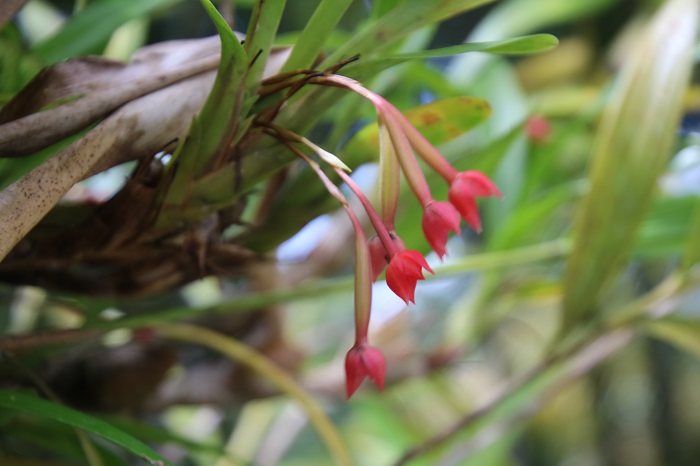 This flower, not an orchid, looked more like a paper origami sculpture than a flower, tiny and delicate.
This flower, not an orchid, looked more like a paper origami sculpture than a flower, tiny and delicate. This one is in the lily family.
This one is in the lily family. 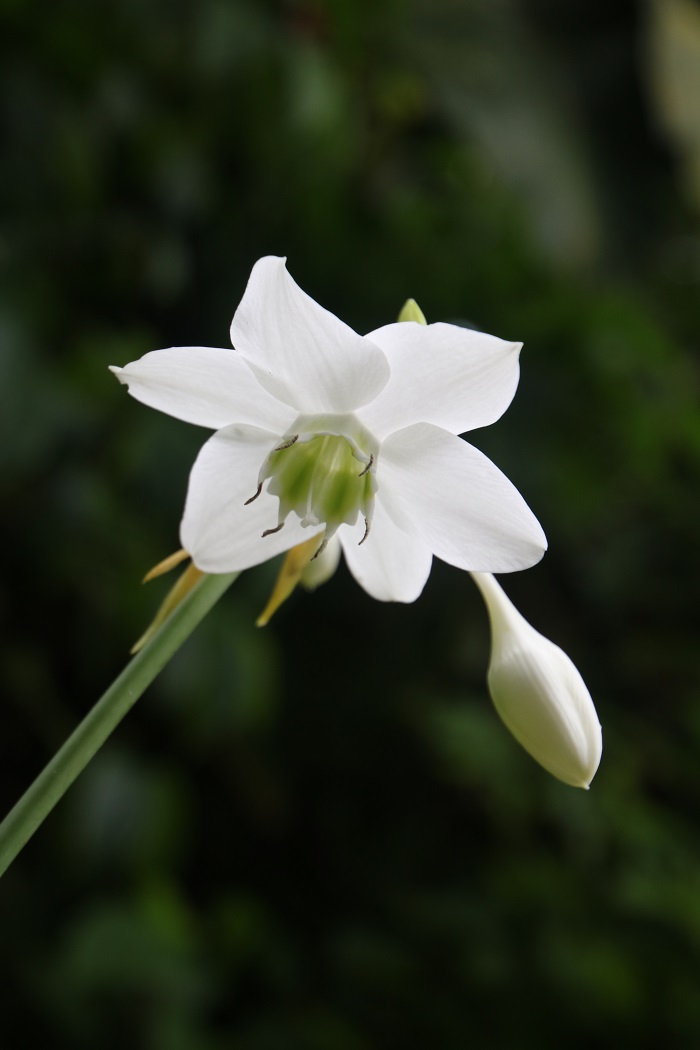 Everything from the towering trees to the smallest twigs were a riot of growth. This heavily laden branch was only about 1/2″ thick.
Everything from the towering trees to the smallest twigs were a riot of growth. This heavily laden branch was only about 1/2″ thick. 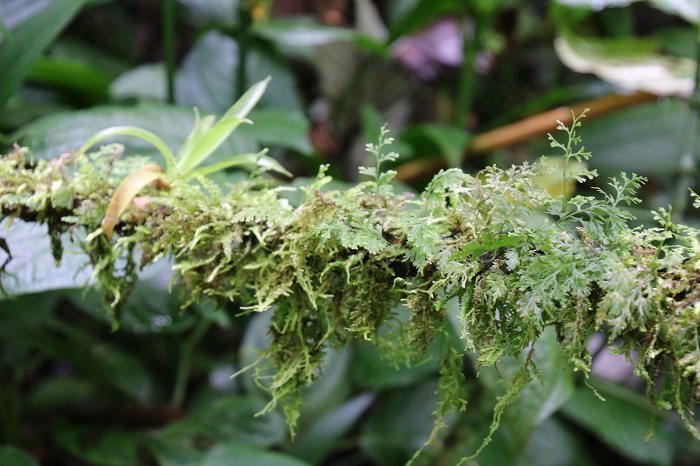 Bromeliads were everywhere.
Bromeliads were everywhere. 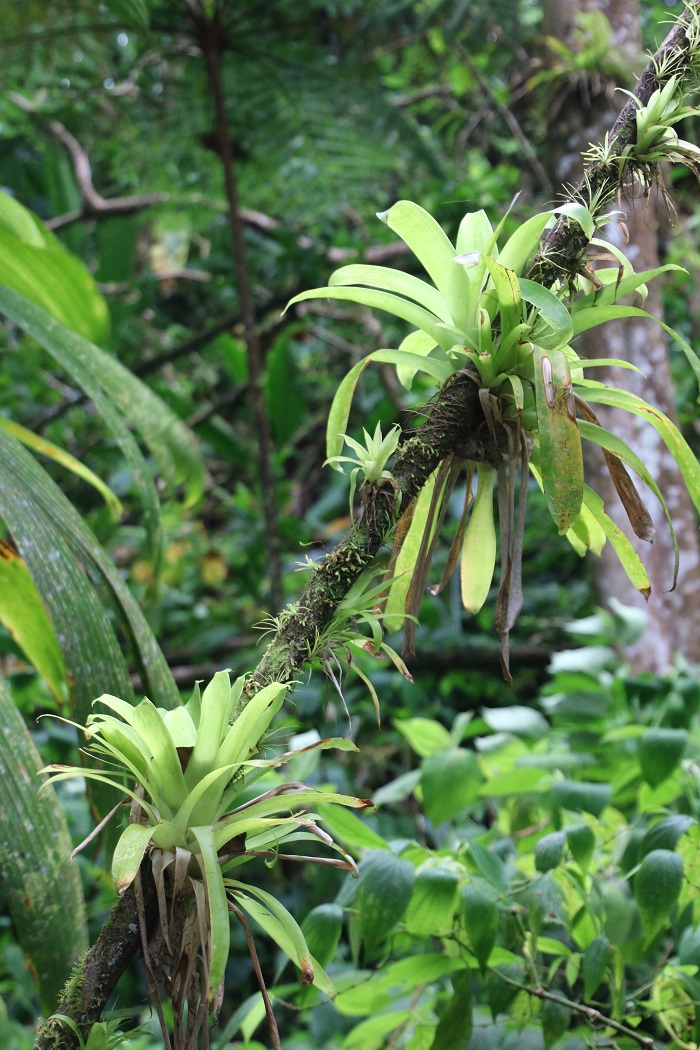 Not your typical Chiquita banana.
Not your typical Chiquita banana. 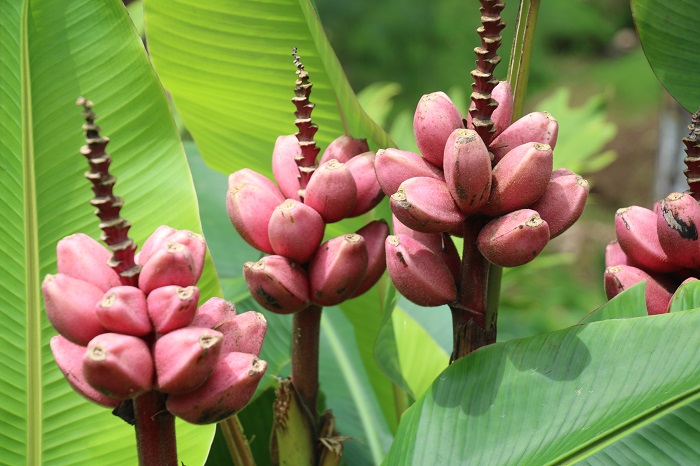 As we walked through the forest there were a number of rough shelters where we could sit and enjoy the solitude and, I expect, escape the rain when necessary.
As we walked through the forest there were a number of rough shelters where we could sit and enjoy the solitude and, I expect, escape the rain when necessary.  Tiny leaves carpeting the trunk of a tree.
Tiny leaves carpeting the trunk of a tree.  The leaves are so small that you’d easily miss them if you weren’t paying close attention.
The leaves are so small that you’d easily miss them if you weren’t paying close attention.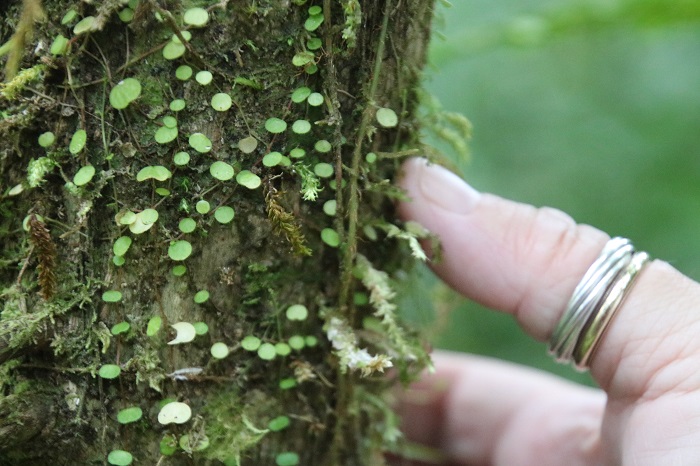 Dainty leaves so fragile it’s hard to believe that they can compete for the available light.
Dainty leaves so fragile it’s hard to believe that they can compete for the available light. A wonderful mix of textures.
A wonderful mix of textures. 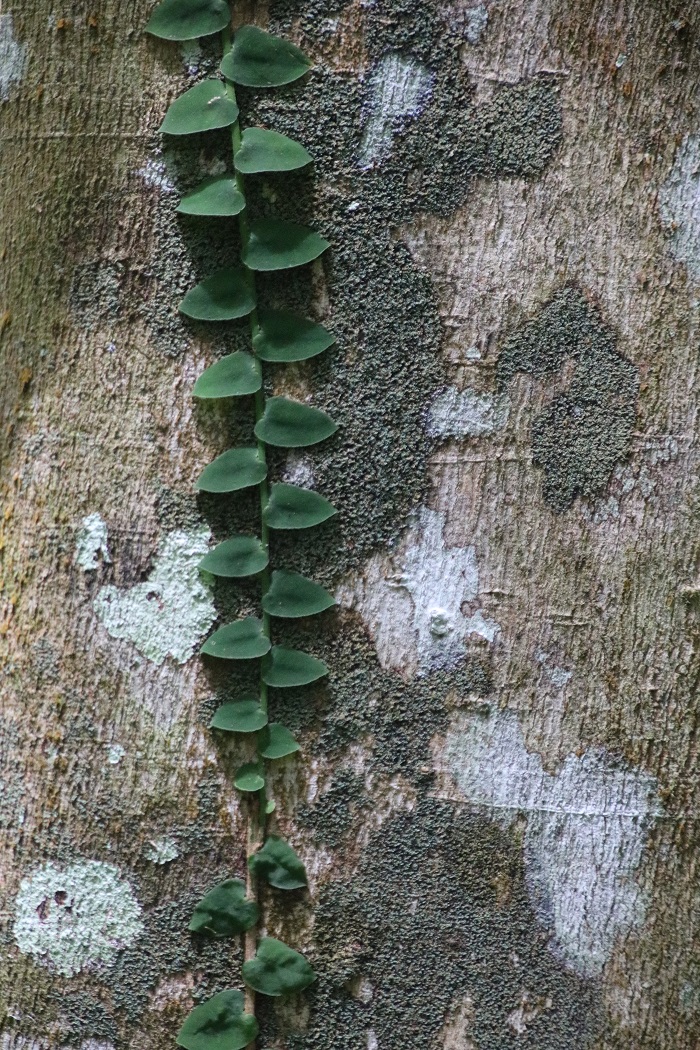 Some not so dainty. This showy bract stands nearly 2′ tall and a flaming red that stands out in the forest.
Some not so dainty. This showy bract stands nearly 2′ tall and a flaming red that stands out in the forest. 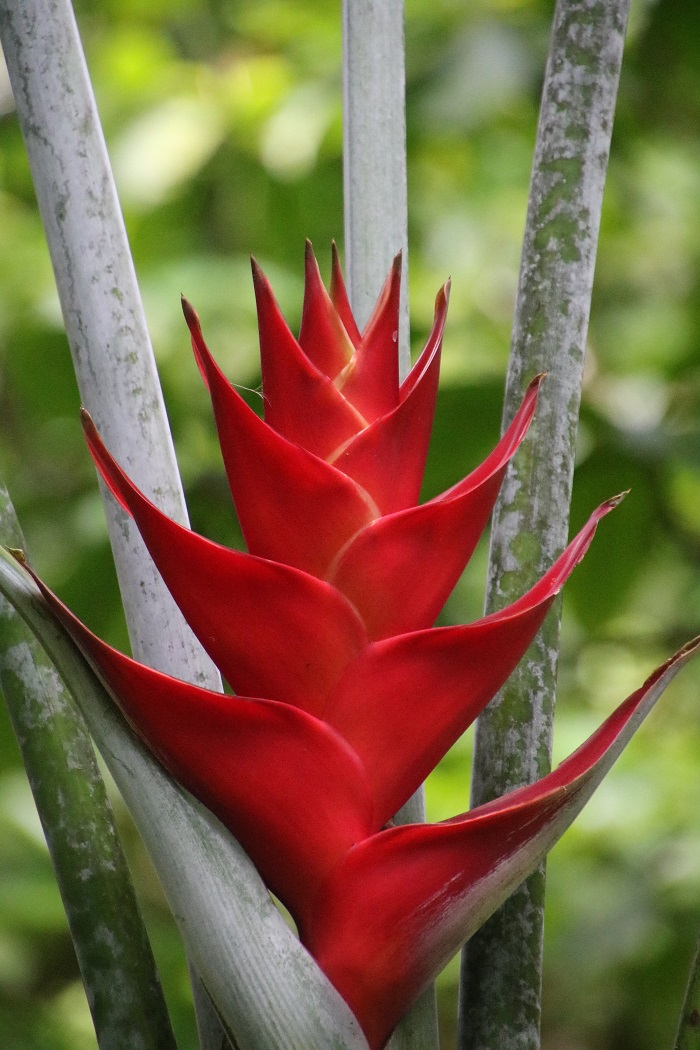 A not so dainty emerging fern fiddle.
A not so dainty emerging fern fiddle. 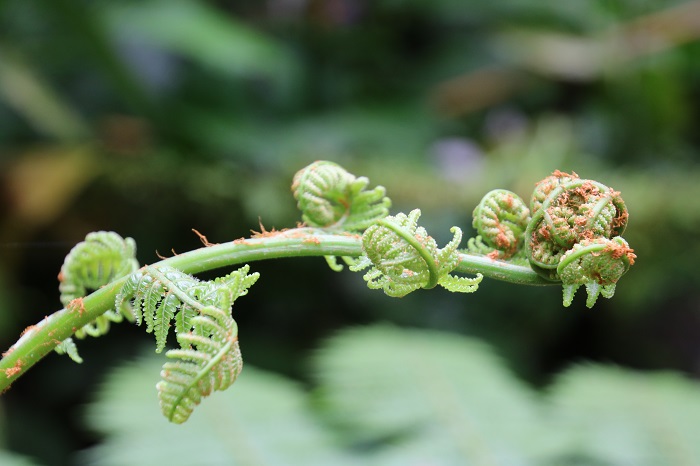 Of course, plenty of massive plants all fighting to reach the sun.
Of course, plenty of massive plants all fighting to reach the sun.  After so many years with our own home greenhouse that required a huge amount of care it’s remarkable to see these plants in their native land, where nature does all her magnificent work.
After so many years with our own home greenhouse that required a huge amount of care it’s remarkable to see these plants in their native land, where nature does all her magnificent work.